
Volume 14 l Issue 2 9772219724008 24014 R55.00 Incl. VAT WINTER 2024 to build MIFPM - a showcase in steel construction p28 Goodbye yellow brick road p44 Thermo Fireplaces and Braais: winter-ready? Is your winter-ready? lighting lighting Get the right indoors - expert advice Building? Building? GARDEN Consider the crucial costs COVER FEATURE where quality and workmanship meet WHAT’S NEW? Luxury home trends Thermo Fireplaces and Braais:












Contact me: Debbie Geary 079 490 8619 | debbie.dynamique@gmail.com Services include: • BDM submission • LUM submission • Admin penalty submission • Heritage Western Cape submission • Occupancy certificate application We assist architectural professionals by submitting and/or overseeing building plan submissions in the Western Cape and surrounds 2 winter 2024 | www.tobuild.co.za www.ixist.co.za info@ixist.co.za Domains Web Hosting Web Design / Development Search Engine Optimisation Google Ads Social Media Marketing Launch Your Site with Ease! Monthly Price R299 Domain Registration (.co.za or .com) (5GB storage, unlimited bandwidth) Hosting (up to 10) Email Addresses (Basic, up to 5 pages) Website design Content Management System (CMS) integration (Available as an add-on) E-commerce Functionality Ultimate Web Starter Pack OUR SERVICES note EDITOR’S Gareth Griffiths editor@tobuild.co.za To Build



• CURING COMPOUNDS • RELEASE AGENTS With uncompromised integrity infused in every one of our products, YOU can expect excellent RESULTS on your projects! Contact us Tel: + 27 11 822 2320 Fax: + 27 11 822 2354 e-mail: cindy@ashak.co.za 8007.b. Shak Construction Chemicals TO BUILD 1/2pg June’24

Fitouts: Where does the office waste go?
Eco-champions: awards are beckoning
Thermo Fireplaces and Braais: where quality and workmanship meet
16 Getting rooftop solar legal: so many questions
18 The home you love for generations to come
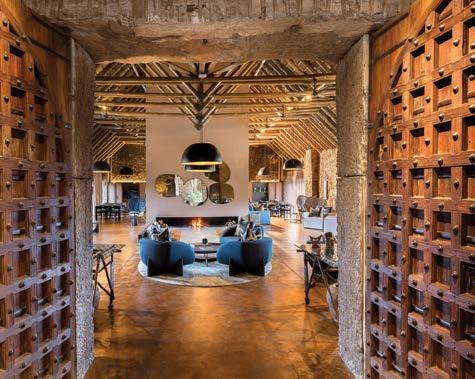
20 Unregistered building contractorsmore harm than good? 22 Contracting with non cidbqualifying entities: tread carefully 24 Building? Consider the crucial costs
28 MIFPM - a showcase in steel construction
Dećor reigns supreme at sensitive eco-tourism development CONSTRUCTION OPINION 40 Construction industry: action needed now
44 Goodbye yellow brick road
46 Making winter a happy hometime 50 Luxury home trends - what’s new? IMPROVEMENTS & MAKEOVERS
54 Does your home have street appeal?

IMPROVEMENTS & MAKEOVERS
58 Get the lighting right indoors –expert advice
62 About that pantry you wanted
ADVERTORIAL: SAINT GOBAIN GYPROC
66 Transforming living spaces: Gyproc's innovative solutions for visual, thermal, and acoustic comfort in South African homes
ADVERTORIAL: INFINITI FIRES
68 Heating your home in winter: the South African dilemma
FIREPLACES
70 This winter: fireplaces
4 winter 2024 | www.tobuild.co.za Contents WINTER 2024 46 36 8 NEWS FROM DESIGN & FITOUT INDUSTRY
NEWS
VIEWS 10
COVER FEATURE 12
PROJECT PLANNING
8
&
ADVERTORIAL: INCANDA
PROJECT PLANNING
PROJECT
34
ENGINEERING
GET
IT DONE
DIY


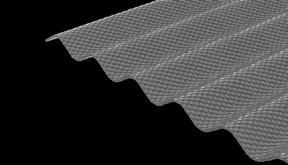








SUNTUF® BEEHIVE EZ GLAZE™ SUNPAL® WE’VE GOT YOU COVERED THIS WINTER PALRAM JOHANNESBURG Tel : + 27 11 3977771 Mobile: + 27 78 450 7784 Dawn.Goossens@palram.com PALRAM CAPE TOWN Tel : + 27 78 8005133 Mobile: + 27 78 450 7784 Dawn.Goossens@palram.com elizabeth.kluckow@palram.com PALRAM DURBAN Tel : + 27 78 4507793 jolene@palram.com
100

ADVERTORIAL: EGGER
74 Market launch of the new Decorative Collection 24+
TIMBER
76 Engineered wood can decarbonise built environment SA FLOORS
80 Green flooring solutions emerging
WINDOWS & DOORS
82 uPVC - a more efficient option for windows?
STEEL, ROOFING & CLADDING
84 Cladding caps an outstanding pan-African steel project
ADVERTORIAL: D&D ROOF INSULATIONS
88 Starlite® roof & side cladding insulation continues to be the forerunner
INSULATION
92 World environment day 2024 and cellulose fibre
ADVERTORIAL: SAINT GOBAIN ISOVER
94 The benefits of effective home insulation
KITCHENS
96 The evolution of bean to cup
ADVERTORIAL: ALLIANCE
98 Alliance Rooftop Inverters: The pinnacle of comfort & climate control
RENEWABLE ENERGY
100 Solar infrastructure – the future of energy security?
GARDEN IMPLEMENTS
104 Is your garden winter-ready?
ADVERTORIAL: ALLBRO
106 Glass reinforced polyester
Credits
To Build
PUBLISHER
Elroy van Heerden Mays elroy@mediaxpose.co.za
EDITOR (& IMAGING)
Gareth Griffiths editor@tobuild.co.za
SUB-EDITOR
Jacky Dyer sub@mediaxpose.co.za
CONTENT MANAGER
Wadoeda Adams artwork@mediaxpose.co.za
EDITORIAL CONTRIBUTORS
Bryan Hack
Danie Hattingh
John de Sousa
Kim Williams
Luyanda Mgqamqo
Michael Pienaar
Roy Southey
Stephanie Forbes
Stephan van Niekerk
Ulrich Pieterse
Yael Geffen
DESIGN & LAYOUT
Shaun van Heerden Mays
Anja Bramley
BUSINESS DEVELOPMENT MANAGER
Rene van Heerden rene@tobuild.co.za
ADVERTISING SALES
Jacqui Marsh jacqui@tobuild.co.za
Lindie van den Abeele lindie@mediaxpose.co.za
DIGITAL AND SOCIAL MEDIA
Kyla van Heerden
Tia Arendse
ADMIN ASSISTANT Ketsia Makola ketsia@mediaxpose.co.za
DISTRIBUTION & SUBSCRIPTIONS: Shihaam Gyer distribution@mediaxpose.co.za
MEDIA PARTNERSHIPS: Maurisha Niewenhuys maurisha@mediaxpose.co.za
FINANCIAL DIRECTOR / ACCOUNTS: Shaun van Heerden Mays
WEBSITE DEVELOPER/ADMINISTRATOR: Justin McGregor
RECEPTIONIST: Daniëla Daniels
RETAIL DISTRIBUTION: On The Dot
AIRPORT DISTRIBUTION: Media Support
PICTURE CREDIT: 123rf.com / pixabay.com
Van Heerden Mays Publications CC t/a Media Xpose Company Reg No: 2010/128859/23
6 Carlton Crescent, Parklands, 7441
Tel: 021 424 3625 | Fax: 086 270 9693
Email: info@tobuild.co.za | Website: www.mediaxpose.co.za















Disclaimer: The views expressed in this publication are not necessarily those of the publisher or its agents. While every effort has been made to ensure the accuracy of the information published, the publisher does not accept responsibility for any error or omission contained herein. Consequently, no person connected with the publication of this journal will be liable for any loss or damage sustained by any reader as a result of action following statements or opinions expressed herein. The publisher will give consideration to all material submitted, but does not take responsibility for damage or its safe return.
6 winter 2024 | www.tobuild.co.za



DAMP PROOFING & WATERPROOFING ASSOCIATION OF
SOUTHERN AFRICA
Maintaining a property can be a daunting task whether you are a homeowner or a property manager.
The Dampproofing & Waterproofing Association of Southern Africa (DWASA) has members in most provinces in South Africa. Backed by many years of training and field experience, there are few damp problems that our members cannot handle.
DWASA is also available to provide inspections and full written reports in the event of disputes and legal issues.
Support to members includes training in working at heights, OHS, fire and safety as well as a 16-module training course qualifying the member as an approved DWASA Damp Surveyor.
Contact us: 0860 103 9272 info@dwasa.co.za



www.dwasa.co.za
PAINTING ADVICE DISPUTE RESOLUTION
DAMP PROOFING WATERPROOFING
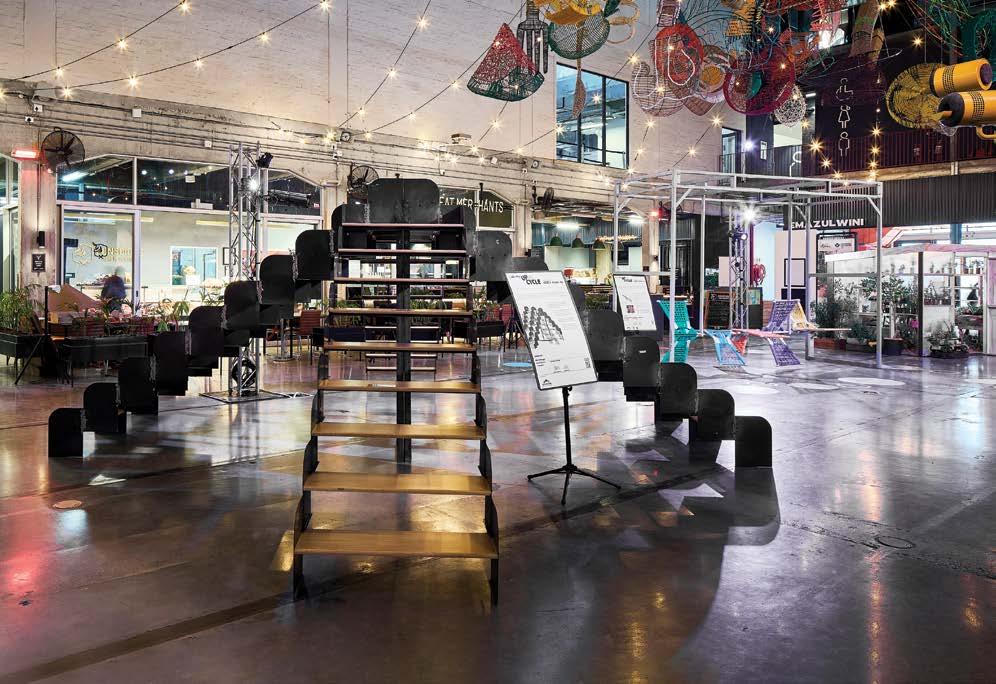
Fitouts: Where does the office waste go?
Launched recently at Makers Landing in the Cruise Terminal, V&A Waterfront, an exhibition named UPCYCLE reimagines the future world of work through circular design, which sees local artists transform discarded office furniture into bespoke art pieces.
Tétris & Gareth Griffiths
The exhibition, a collaboration between Sanlam, leading global property advisory company JLL, and its subsidiary interior design firm Tétris Design and Build, showcased the design, build, and furniture business. It featured the work of several creators, and each piece of art was given a sustainability score.
Post Covid-19 and new hybrid ways of working, over a third of all global office desks are empty all week, according to Bloomberg. And each empty office chair ‘costs’ about 72 kg COe in carbon to manufacture. Office furniture significantly impacts an industry, accounting for about 30% of all greenhouse gas emissions. With much of it sitting in storage or piling up in local landfills, it often costs more to fix than replace, further driving the unsustainable process. Most of it is made from petroleum-
derived synthetic materials, so it quickly becomes a polluter of the planet.
Tétris commissioned big-name local African creators, including Patrick Bongoy (shortlisted for the 2024 Loewe Foundation Craft Prize in Paris), Laurie Wiid (Wiid Design), Hoven Design, Ananta Design Studio, and the Tétris Global and South African teams – to craft bespoke repurposed art pieces from Sanlam’s outdated office furniture. The artists were invited to select the office items they wanted to work with. Sarene Nel, MD of Tétris SA and Netherlands, puts their role into perspective: “By partnering with leading clients, designers and suppliers, we can make positive change. We aim to reduce waste and create efficiencies that work for the environment and the community.”
Karl Socikwa, Group Executive of Market Development and Sustainability at cosponsor Sanlam, says the giant financial group is extremely mindful of how outdated office items are discarded. “So, this collaboration felt like a natural fit. This was an out-the-box, creative way to work with local talent to repurpose furniture to be relevant and resaleable.”
Elaine O’Connor, Head of Fit Out, Project & Development Services, MEA, represented JLL/Tetris in the MEA at the exhibition opening. We asked her to comment on how global sustainability goals have influenced Group strategies and implementations in property development and fit-out services.
“Global sustainability goals, such as those outlined in the United Nations’ Sustainable Development Goals (SDGs), have
NEWS FROM DESIGN & FITOUT INDUSTRY
8 winter 2024 | www.tobuild.co.za
significantly impacted property development and fit-out services. These goals address critical environmental, social, and economic challenges and promote sustainable development worldwide.
“In response to these goals, many companies in the real estate sector have incorporated sustainability considerations into their strategies and practices. This includes incorporating sustainable design principles, adopting green building certifications (such as LEED or BREEAM), and embracing energy-efficient technologies” she says.
Context
O’Connor says sustainability is often integrated into a property’s entire lifecycle, from the initial design and construction stages to the ongoing operation and maintenance. This includes using sustainable building materials, implementing energy and water-efficient systems, promoting waste reduction and recycling, and creating healthy indoor environments.
“There has been an increased focus on creating spaces that promote employee well-being and productivity. This includes incorporating natural lighting, green spaces, and enhanced indoor air quality. Buildings with sustainable features and certifications can attract tenants who value sustainability and may offer cost savings through energy efficiency.
“Another important aspect influenced by global sustainability goals in property development and fit-out services is the emphasis on reducing carbon emissions and mitigating climate change impacts. To address this, strategies have been implemented to reduce energy consumption, decrease reliance on fossil fuels, and increase the use of renewable energy sources.
“Strategies have also been developed to promote more sustainable transportation options and reduce the carbon footprint associated with commuting and business-related travel. This includes locating developments near public transportation networks.”
By aligning with global sustainability goals, property developers and fit-out service providers can contribute to reducing carbon emissions and supporting a more sustainable and resilient built environment. In her opinion, this not only benefits the environment but also helps improve the overall reputation and marketability of properties in an increasingly sustainabilityfocused marketplace.

Seen at UPCYCLE: Elaine O’Connor is a qualified quantity surveyor with a background in project management, main contracting, and fit-out contracting and leads both JLL’s Fit Out team across the Middle East and Africa (MEA) and is the Head of Project & Development Services Egypt & Africa.



Fabrics reclaimed from disused acoustic panels have been reconstituted to create a custom fieldwork PPE garment, which includes an upcycled riot helmet recovered from an abandoned furniture storeroom. An unconventional and multidisciplinary architecture, interior design, film and exhibition studio Hoven brought its experimental approach to the UPCYCLE exhibition. By combining their overlapping interests, the duo shape a unique approach to projects and imagining new possibilities within an African context. The Van der Hovens have been involved in the architectural and interior design of workspaces such as Workshop17’s The Bank, Firestation, Kloof Street and Tabakhuis buildings, where they rethought the future of the physical, digital and experiential workspace and developed new space typologies designed for flexibility, variety and choice.
NEWS FROM DESIGN & FITOUT INDUSTRY
Designed by Nisha and Justus van der Hoven
Birdhouse - by Laurie Wiid Design uses 75% recycled office waste.
Oxygen Farm Work Pod - by Lesley Joemat and Tree-preneurs - 93% recycled materials.
www.tobuild.co.za | winter 2024 9
Studio Hoven - PPE garment.
Eco-champions: Awards are beckoning
Entries for the 2024 Eco-Logic Awards, a vibrant celebration of South Africa’s eco-champions, groundbreaking projects, and innovative solutions, are now open.
Eco-Logic Awards
The awards, which have been running for over 12 years, serve as a call to action, supporting initiatives that benefit ‘People and Planet’, ignite inspiration, and empower consumers to embrace eco-conscious choices and decisions daily. They honour the pioneers and innovators spearheading the movement towards a more sustainable future.
David Parry-Davies, editor of The Enviropaedia and founder of the EcoLogic Awards, emphasises, “The awards are a platform not only to recognise EcoChampions but also to inspire consumers to support sustainable initiatives through their purchasing power."
This year, the event has partnered with Biomimicry SA (www.biomimicrysa.life/ what-is-biomimicry), marking a significant milestone in advancing environmental practices to heal and protect our planet.
Biomimicry draws inspiration directly from nature and involves learning from and emulating nature’s ingenious solutions to tackle human challenges. “A great example is the beak of the Kingfisher, which inspired the redesign of the Shinkansen Bullet Train in Japan, resulting in increased speed and reduced energy consumption whilst solving the problem of the loud sonic boom each time the train exited a tunnel,” says Jane Lourens, Co-Director of BiomimicrySA.
The awards ceremony at the Two Oceans Aquarium, V&A Waterfront in Cape Town on

October 30, 2024, will be televised on PPL°PLANET (OpenView Channel 115), available to millions of households throughout South Africa. The event will honour gold, silver, and bronze winners across 12 categories, including Climate Change, Nature Conservation, Water Conservation, Circular Economy and Waste Innovation, Eco-fashion and Lifestyle, Eco-health and Wellness, Eco-hospitality and Tourism, Eco-Innovation, Eco-Friendly Products, Eco-Communities and Schools, Eco-Angel, and EcoWarrior. There will also be an environmental talks and workshops programme.
Hurry: If you’re a dedicated Eco-Champion or want to nominate someone who is, submissions are welcome until June 30, 2024, at www.eco-logicawards.com, advises Parry-Davies.

10 winter 2024 | www.tobuild.co.za
NEWS & VIEWS
Minister of Environment, Forestry and Fisheries Barbara Creecy honours Eco-Logic Awards winners
Circular Economy & Waste Innovation Winner 2022: Leanne Kiezer of Danone SA (left) with MC Zandile Ndhlovu (The Black Mermaid) (right)





Tel: 011 434 0444, Email:Shantelle@chairexpress.co.za 44 Hulbert Rd Cnr Rosettenville Rd, New Centre, Johannesburg T & C Apply. E & OE www.seatsahead.co.za VENUS
Thermo F ireplaces and B raais:
where quality and workmanship meet
When it comes to creating a cosy and inviting indoor or outdoor living space, a fireplace and /or braai is a must-have, says our cover story contributor, Thermo Fires (www.thermofires.co.za).
Not all fireplaces and braais are created equal. At Thermo Fires, we pride ourselves on our exceptional quality and workmanship. Our fireplaces and braais are built to last, using only the best available materials and construction methods. So confident are we in our quality, that we are the only company to give a 20-year warranty on our fireboxes.

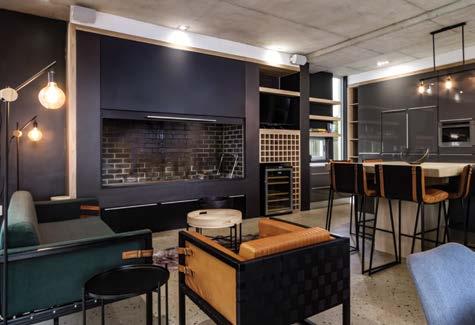
20-year warranty on our fireboxes
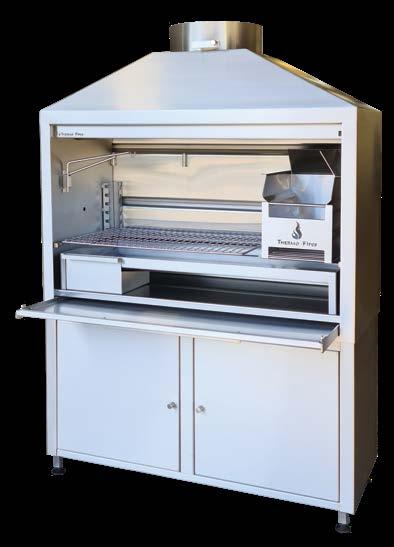
Design and Versatility
From design concept to the final product, we do everything in-house. Thermo’s innovative designs cater to various tastes and décors. From modern and sleek to traditional and rustic, our fireplaces blend seamlessly into any home. With freestanding units that can double as room dividers, to wall-standing and corner units, we also have multiple ranges of built-in fireplaces and insert options. Homeowners can choose the perfect fit for their space.
Attention to Detail
At Thermo, we understand that it's the little things that make a big difference. That's why we pay close attention to every detail, from the design to the precise engineering of our fireplaces and braais. Our products are designed to be both functional and beautiful. Our team of skilled craftsmen and machinists are dedicated to their craft, taking pride in every product that leaves our factory.
COVER STORY
12 winter 2024 | www.tobuild.co.za
Benefits of a Thermo Wood-burning Fireplace
Wood-burning fireplaces have been shown to have health benefits, such as reducing stress and promoting relaxation. The warmth and ambience created by the fire can also help alleviate symptoms of winter blues.
Our wood-burning fireplaces are a popular choice, available in a range of designs and sizes to suit various spaces and styles. They can be installed into existing fireplaces or as a standalone unit, offering flexibility and convenience. The built-in convection channels and glass door/s on our units result in more heat output and less waste, saving you money and making our units an environmentally friendly option.
Our most popular and cost-effective freestanding units are our Slimline and Corner ranges. Whilst the Slimline range is wall-standing, the corner unitunique to Thermo Fires - was designed to tuck neatly into an unused corner of your room. It radiates the heat at 90 degrees, with a view of the flames from all angles. We also offer 4 and 8-sided units with glass on all sides, perfect to utilise as a room divider, as well as various designs of wall-standing and corner units.
Our built-in and insert fireplaces are also manufactured with convection channels and a damper unit, and are available with a door with adjustable air intake. This gives you total control over the amount of oxygen allowed into your fireplace, which in turn controls how hot or fast the fire burns and how much heat is radiated into the room.


Benefits of a Thermo Braai
Thermo Fires offers you one of the most extensive ranges of indoor and outdoor braais. From our unique grid design to our grade 304 stainless steel braai grids, it will earn you the envy of your friends.
Our hottest seller currently is our professional range of builtin braais. This range has been designed with modern clean lines. When closed, the single door makes a statement, whether mildsteel (black) or brushed stainless steel, no matter your design aesthetic. When opened but not needed, the door slides neatly out of the way underneath the ashpan but is easily pulled out to be utilised as a workspace.
This range also includes spit braais, combination braais and freestanding braais.
Thermo Fires’ uniquely extensive range of combination braais – a single braai divided into a wood-burning and a gas BBQ section - gives you the freedom to choose whether to braai on wood or gas, as your available time dictates. Available in nineteen sizes and options, from 1200 mm to 2250 mm wide.
Do you want to avoid the mess of building alterations to fit a built-in braai? Our freestanding braais are available on a choice of a pedestal or cabinet, standard with 2.4 m flues, turbo cowl and ceiling plate. Thermo was the first company to manufacture a freestanding braai with double-skinned sides to keep the outside cooler to the touch.
Conclusion
If you're looking for a high-quality fireplace or braai that will provide years of enjoyment and warmth, look no further than Thermo Fires. Our commitment to quality and workmanship ensures that our products will exceed your expectations. Contact us today to learn more and take the first step towards creating your dream indoor or outdoor living space.

COVER STORY
www.tobuild.co.za | winter 2024 13

At Thermo Fires we can custom make anything you can dream of. Above is a full grade 304 stainless steel combination braai that also includes a spit on the side


Not only do we o er custom-made units to your speci cation, we also o er a vast range of standard products, above are two images of our Blaze range. A Blaze 1 that is the perfect room divider and a Blaze 2 that can be installed against a wall



THERMO FIRES is a privately owned, proudly South African family business. With over 20 years of experience in the design and manufacture of braais and replaces, the name THERMO has become synonymous with one of the largest ranges of quality and custom products. As proof of our commitment to our product, Thermo is the only company to give a 20-year warranty against faulty workmanship..
Even with our vast range, we understand that some customers prefer or need a unique unit. We therefore have a crew specializing in customdesigned units.
Thermo Fires Leadership through Quality 021 200 7660 info@thermo res.co.za 18 Viben Avenue www.thermo res.co.za 076 097 3347 Brackenfell Industria Western Cape 021 981 1988



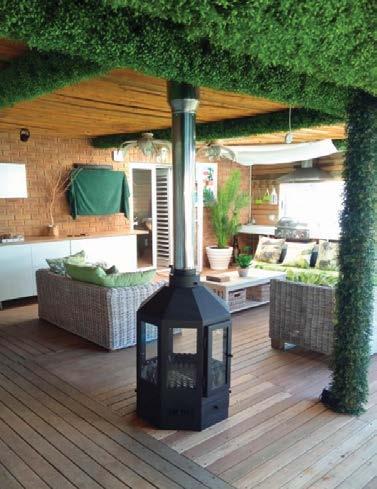
QUALITY INDOOR FIREPLACES BY THERMO FIRES


Not only does Thermo Fires design and manufacture braais, but we also manufacture a large range of standard and bespoke indoor freestanding and built-in replaces.
Our bestsellers are currently our Slimline and Corner freestanding ranges. While the Slimline range is designed to be wall-standing, the Corner unit - unique to Thermo Fires - was designed by us to tuck neatly into an unused corner of your room, radiating heat at 90 degrees, with a view of the ames from all directions.
These ranges are available in four sizes. The unit incorporates convection channels and a door with adjustable air intake, as well as 3.6m stainless steel ues. The door turns this replace into a slow-burning unit that burns more e ciently, using less wood while radiating more heat into your room.
Want something to make a statement? We also manufacture Square & Octagon units. With our 20-year quality warranty you simply cannot go wrong!


Getting rooftop solar legal:
So many questions
There are national rules and regulations and then there are municipal regulations. Following questions from readers, we asked four of the largest South African metropolitan regulators to explain the red tape involving the approval of home PV installations. To date, three months on, just two metros, City of Johannesburg and City of Cape Town have responded.
Gareth Griffiths
While a Certificate of Compliance is mandatory for any electrical work done to any home’s wiring in SA, additional measures have been put into place requiring municipal plan approval for any additions to what is technically referred to as Small Scale Embedded Generation (SSEG) systems, a catch-all term that refers to the connection of even the smallest solar panel to the wiring of the house. It is clear that, under the prevailing regime, a one-size policy has to fit all. So here are the main questions we put to the relevant spokespeople:
1 Can you please explain the process of getting approvals for solar backup and battery inverter backup in the home? What is allowed without getting municipal approval?
Cape Town - answers by Cllr Beverley van Reenen, the City’s Mayco Member for Energy.
“All SSEG (Small Scale Embedded Generation) systems in the City of Cape Town supply area, including battery systems without solar PV (i.e. home UPS inverters), need to be registered and authorised. Solar PV geysers (with PV panels) which power electric geysers will also need to be registered. This is required to manage and operate a safe and legal grid. Increasingly the grid is under extreme pressure when power is restored after loadshedding due to
embedded generation and energy storage systems. By adhering to the City’s requirements, customers support a safe and functional electricity network. See: www.capetown.gov.za/SolarPV
“The current authorisation process can take between three and six months. However, a streamlined online registration is launching soon.
“The following do not require authorisation: solar water heaters (thermal), solar security/garden lights, and portable UPS trolley inverters that you plug into a wall socket. The registration and authorisation process is free. However, some installers may charge you to complete the registration process. Ensure that your quote includes all the relevant items for a compliant system.”
City of Johannesburg - Answers from Isaac Mangena, spokesperson for City Power. “City Power has developed Small Scale Embedded Generation application processes, and information regarding registration enquiries can be sent to jozipvpower@citypower.co.za
Both grid-tied and non-grid-tied installations are treated as grid-tied since customers still have City Power’s electricity service connections. Grid-isolated installations have the possibility of back-feeding, therefore, to ensure the safety of personnel operating on the grid, both systems must be declared, tested and certified.
Significantly, however, City Power requires no application for the installation of home UPS/ battery inverters. “Due to the adverse effects of continued load shedding, customers have opted to install backup inverters. Customers with these types of systems are encouraged to inform City Power as there is the possibility of adding PV panels in future” says Mangena.
PROJECT PLANNING
16 winter 2024 | www.tobuild.co.za
2We have heard that the make of the components that make up a working solar PV or UPS/battery backup power system need to be approved also, in other words, there is a list of accredited suppliers. If yes, does this not prejudice the smaller suppliers who want to join the supply chain, and how easy is it for them to get accredited?
City of Cape Town (Van Reenen)
“Our City maintains a list of NRS 097-2-1 type test-approved inverters in an attempt to protect our customers from purchasing and installing equipment that does not meet the requirements for grid interconnection. The City’s requirements for grid-tied inverters (GTI’s) and ancillary equipment (e.g. network and system grid protection voltage and frequency relay) type test certification are explained in Appendix 3 in the requirements for SSEG document. For more information and how to apply, suppliers can email: inverter.approval@capetown.gov.za
“The City does not appoint any suppliers for inverters. Any supplier may apply
for their equipment to be added to the approved inverters list. The City confirms that the equipment complies with the relevant standards and that the testing has been performed by a 3rd party accredited body. We follow a fair and transparent process and do not endorse any suppliers or manufacturers.”
Is this due to safety/fire risk observations?
“Data related to fires is not held by the Energy Directorate, however anecdotal evidence from the insurance industry suggests that insurance claims for fires related to poor quality electrical installations is rising exponentially. Furthermore, the
safety risks go beyond the household risk to include risks to municipal employees working on the electrical grid and on the electrical network equipment itself.”
Johannesburg City Power (Mangena) (TB: It appears that Johannesburg leaves that responsibility up to the installer and the complying electrician. Herein lies a significant difference between the policies of the two metros.)

“As part of City Power’s Small SEG requirements, any installation within City Power’s areas of supply must be designed by a qualified professional registered engineer or professional registered technician, and wired by a qualified electrician who is accredited by the Department of Labour. Upon commissioning, a certificate of compliance is to be submitted with a commissioning report.”
3
Any final comments?
Mangena: “Any source of power generation behind the meter must be registered with (Johannesburg) City Power. This is because these UPS systems intersect with our network. City Power requires this information to ensure that customers are educated on how to prevent these systems from triggering overload-induced trips, particularly during higher stages of loadshedding. We often urge customers who have installed these facilities to delay starting up inverters and battery systems when electricity returns after loadshedding to avoid a demand peak after every planned outage.”
Van Reenen: “The City (of Cape Town) is actively working to encourage the uptake of safe and legal SSEG, through several measures including standardisation of the systems permitted; developing an online registration process; providing an incentive feed-in tariff; permitting SSEG feed-in credit to offset one’s entire municipal invoice, after which customers can earn cash for power; and significantly reducing the monthly advanced metering infrastructure administration fee."
TO BUILD will continue to try and get your questions answered in subsequent editions. Please send feedback and questions to: editor@tobuild.co.za
PROJECT PLANNING
www.tobuild.co.za | winter 2024 17
The home you LOVE for generations to come
Home is where our stories begin and therefore where our hearts are. It is where memories are made with family and friends, where we express our individuality, and our retreat when we need solitude.
That is why Incanda has always strived to offer people more than just furniture. It has blossomed into a proud South African lifestyle brand encompassing the essence of South African living.
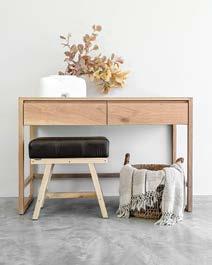



Nestled in the heart of the historic town of Paarl, the Incanda factory services its seven showrooms in the Western Cape, the Free State, and Gauteng. Here, customers can fully immerse themselves in the look, feel, and smell of the wide range of furniture upholstered in genuine leather or luxurious fabrics, as well as meticulously crafted wooden pieces manufactured from local, sustainably sourced blackwood or imported American oak.
The ever-expanding range is founded on the dual principles of using only high-quality raw materials and having a dedicated team of passionate artisans to manufacture every piece by hand; this ensures products that exemplify quality and durability. The designs are always clean, elegant, and timeless. Incanda’s furniture is made for living, to gain character over time and eventually to become heirlooms for future generations.
The commitment to excellence and to playing an essential role in people’s individual stories extends beyond the manufacturing process to the people who are at the heart of this brand. Every interaction with this special group of individuals, from the sales staff to the delivery teams, is marked by warm greetings and a dedication to outstanding service. Customers become part of the Incanda family and are, therefore, truly valued.
Incanda has a team of interior designers who take the time to get to know their customers and to help them bring their unique visions to life. They are always informed about the latest trends but also acutely aware of which styles will be lasting. Regarding all the add-ons - the finer touches that help transform spaces into stylishly curated rooms - Incanda is undoubtedly at the forefront of interior design, offering unique, carefully selected décor to complement the Incanda style and blend in with the lifestyle.
Visit Incanda and enjoy a truly unique experience. Their showrooms are located in Paarl, Somerset West, Durbanville, Hermanus, Bloemfontein, Kramerville, and Menlyn. Visit their website for directions and contact details or to view the entire range of furniture online by following this link: https://incanda.co.za.
18 winter 2024 | www.tobuild.co.za
ADVERTORIAL

TOWERS MAIN | JOHANNESBURG CBD URBANISM

GLENHOVE OFFICES
ICONIC ARCHITECTURE

TRANSFORMATION
CCB | SANDTON
Unregistered building contractorsmore harm than good?
The Building Industry Bargaining Council (BIBC) in South Africa argues that hiring registered businesses is more than just cost-and-time savings; it’s for the country’s greater good.
Danie Hattingh and Luyanda Mgqamqo (BIBC)

As much as addressing South Africa’s dire unemployment rate is critical, building industry role players recommend that businesses and members of the public tread carefully when securing the services of unregistered contractors.
From a company owner’s perspective, being a registered entity means meeting quality standards, construction regulations, and customer expectations, all of which promote higher standards of workmanship, safety, and project delivery.
However, a set of findings by the BIBC indicates that businesses not registered with their organisation need the basic
infrastructure to deliver quality outcomes. In addition, they often miss deadlines and budget targets.
The BIBC’s council spokesperson for business, Danie Hattingh, says the council has seen many examples of work having to be redone to address these quality concerns.
“The direct result of this is that the contractor responsible has narrower profit margins or has eroded margins due to the penalties imposed by the ‘provider of work’. The delays that result from having to redo work have financial implications for all parties caught up in this unfortunate scenario.”
PROJECT PLANNING
20 winter 2024 | www.tobuild.co.za
The impact on unregistered employees is equally severe.
While unregistered employment accounts for 38% of all jobs in South Africa’s construction sector, of which the building industry forms a large part, the workers that fill these jobs are not typically protected by labour laws that govern minimum wage requirements, overtime pay and workplace safety regulations.
Unregistered employers also frequently exploit labour to undercut competitors. Unregistered labourers may not receive the negotiated minimum benefits applicable in the industry and accept whatever the non-compliant employer arbitrarily decides. These arrangements also often lack stability and security, with workers uncertain about future income and job prospects.
The BIBC’s council spokesperson for labour, Luyanda Mgqamqo, points out that these employees often encounter irregular working hours, fluctuating income and reliance on temporary work.
“We are also concerned to note that these employees and their dependents are also not protected in the event of their death and disability,” he says.
Conversely, employees registered with compliant employers receive daily contributions towards their annual (holiday) leave, sick leave, retirement fund and bonus.

For example, the BIBC collected and paid out more than R200 Million in leave pay and bonuses at the end of 2023—funds that went directly into the pockets of employees whose registered employers had contributed on their behalf throughout the year.
Another positive spinoff was that contributions were made towards more than 28 000 registered building industry employees for future funeral, death and disability benefits.
It has become evident that employees registered with the BIBC are usually part of stable teams in which skills are transferable and complementary. This generally results in a higher standard of work as individuals
who operate within these teams are more responsible and accountable.
Hattingh emphasises that failure to address the gaps between registered and unregistered parties can be detrimental to the industry and the economy.
Unregistered labour can compete unfairly with registered contractors by circumventing regulations and standards. This may hinder government tax collection, infrastructure development and efforts to promote sustainable housing solutions.
“Where both the provider of work and the contractor have a culture of non-compliance, the impact on sustainable and decent employment is even more pronounced,” he adds.
Collective bargaining ensures that all employers in the industry compete on unique selling points such as excellent work and quick turnaround times stemming from skilled and stable teams.
Here, the BIBC has been instrumental in driving the transition from unregistered to registered employment by establishing standards, negotiating agreements, managing compliance, offering support services and promoting dialogue and collaboration among stakeholders.
Hattingh says that when engaging with a building contractor as a ‘giver of work,’ it is important that the firm is properly registered with the BIBC, as this provides assurance that a business is not enabling labour exploitation.
“Businesses have a critical role in promoting registered employment by ensuring that only employers who adhere to legal requirements are contracted to work in the building industry.
“Provers of work can visit the BIBC website (www.bibc.co.za) to see whether the contractor is registered with the BIBC and is compliant. Our experience is that when employers are compliant with the BIBC there is a higher likelihood that they are compliant in other areas, such as adherence to health and safety and unemployment insurance regulations.”


PROJECT PLANNING
The positives
Luyanda Mgqamqo
www.tobuild.co.za | winter 2024 21
Danie Hattingh
CONTRACTING WITH NON CIDB-QUALIFYING ENTITIES:
tread carefully
Further to our article by the BIBC on hiring unregistered contractors, we asked our legal eagle, Adv. Bryan Hack, to comment on specific legal implications of noncompliance from another angle. He looks at recent case law involving the Apex Court and advises readers against ignoring the qualifying criteria of the CIDB.
Adv. BC Hack
The consequences of awarding a contract to entities that are not adequately able to execute the works were recently considered and addressed in the Constitutional Court, which ruled on a leave to appeal matter that followed a drawn out process, beginning with a tender for essential services to the public that was wrongfully awarded by a local authority in 2011.
In Esorfranki Pipelines (Pty) Ltd v Mopani District Municipality 2023 (2) SA 31 (CC), the court had to consider whether a party could claim pure economic loss in terms of our common law for a breach of a right enshrined in the constitution.
I do not intend to comment on this legal issue, which is more suitably addressed in a law journal. However, parts of the judgement are relevant to the vexing question of how to provide opportunities for previously disadvantaged persons without sacrificing standards. This goes to the question of whether regulatory bodies still have a role in sustaining standards or whether they should not be permitted to stifle the need to create opportunities for persons who cannot necessarily meet the criteria or standards the regulatory bodies seek to impose.
The facts of the case are, briefly stated: a Municipality awarded a contract to a (joint venture) contractor who failed to meet the Construction Industry Development Board (CIDB) scoring criteria*. A losing party to the tender instituted court proceedings, which ultimately included a claim for damages, namely the loss of profit it would have received if it had, as it alleged, been awarded the tender as it should have in a proper process.
The court had this to say about the Municipality’s conduct and, of importance to the point under discussion, its consequences.
In paragraph [42], the court says: ‘The intensity of the respondent’s (the Municipality’s) fault is also relevant to the wrongfulness enquiry. In this case, the respondent’s conduct was reprehensible and deserving of sanction. The applicant’s evidence that the respondent manipulated the scoring of the tender and overlooked the joint venture’s inadequate CIDB score was uncontested. In the face of these patent irregularities, the respondent was plainly required to take steps to properly assess the applicant’s allegations and assure itself that the tender had been lawfully awarded. Instead, at every turn, the respondent acted to ensure that the award was implemented and, as a result, an entity plainly unsuited to implement the award squandered vast sums of taxpayer money.
A project which should have cost approximately R200 million ended up costing the fiscus approximately R800 million. And worse still, this was a project intended to mitigate the effects of drought and to ensure that the residents of Giyani had water. Why the respondent acted to advance the interests of the joint venture is unclear, and further investigation by the relevant authorities is undoubtedly required. What is clear, however, is that the respondent’s unconscionable conduct harmed the rights and interests of the residents it was duty bound to protect, egregiously violated the applicant’s right to just administrative action, and prejudiced the country generally by squandering taxpayer money.”
These criticisms are a salutary warning to “employers” (as understood in the building industry, namely owners of property who employ contractors) in properly vetting contractors to ensure they are adequately capable of executing the works. Such a vetting process would require confirmation of registration with regulatory bodies.
* Footnote - as noted by the Apex Court: According to the CIDB, designations are assigned on the basis of the financial and works capability of the contractor. A designation of 1 reflects the lowest capability and a designation of 9 the highest. Contractors are also designated according to the class of work they perform with a “CE” designation indicating a civil engineering entity while “PE” is allocated to a potentially emerging entity. A “PE” designation will be allocated if an entity’s principals are previously disadvantaged persons who own at least 50% of the enterprise, exercise authority and manage the assets and daily operations of the enterprise, and exercise appropriate managerial and financial authority in directing the operations of the enterprise. An entity designated as “PE” may, if various further conditions are met, be treated as having a contractor grading designation one grade higher than that for which it is registered.
The ruling of the Constitutional Court may be accessed here in the public domain: https://www.saflii.org/za/cases/ ZACC/2022/41.html
Bryan Hack can be contacted on hack@capebar.co.za

22 winter 2024 | www.tobuild.co.za
PROJECT PLANNING











Building? Consider the crucial costs
Professional architect
Ulrich Pieterse advises that planning a building project can be exciting but daunting the first time around, with many costs exceeding the initial construction budget.
Ulrich Pieterse
UNSPLASH
Beyond the obvious expenses of materials and labour, there are other costs and unforeseen expenditures that may not be obvious to the client. These include regulatory compliance fees and postconstruction expenses. This article looks at the financial implications of building projects, allowing property owners who plan to build to understand these complexities.
Property acquisition costs
When looking to buy property to build on, consider these costs:
• The price tag on the property itself, which can vary depending on where it is, how big it is, and the demand for it.
• Legal fees, preparing paperwork and doing title deed searches to ensure the sale is legitimate.
• Transfer duties and taxes as per government requirements.
It's all about finding the perfect property, planning your finances well, and fully considering all the legal fees so you can nail that property deal smoothly.

How architects charge
When determining their fees, architects typically consider several factors, including the scale and intricacy of the building project, materials employed, and the projected duration for completion. Their fees must adhere to the guidelines set by the South African Council for the Architectural Profession (SACAP). It is important to note that your architect must be professionally registered with SACAP and should be able to provide you with their registration number. Where the architect is not registered in the correct SACAP category, the relevant local authority will not accept a submission for building work approval.
PROJECT PLANNING
24 winter 2024 | www.tobuild.co.za
Planning and design costs
These are fundamental considerations when gearing up for a construction project.
1. Architectural and engineering fees play a pivotal role in creating the blueprint for your project, covering the design, structural integrity, and aesthetic considerations. These professionals bring expertise, ensuring your vision aligns with practicality and safety standards.
2. The structural engineer is tasked with determining the optimal design and structural system for the building envisioned by your architect. They carefully assess factors like soil conditions, which are crucial for selecting the appropriate foundation type. Sometimes, a geotechnical report may be necessary to inform this decision, directly influencing project costs.
3. Quantity surveyor fees are essential for accurate cost estimation and budgeting. They provide insights into material quantities and associated expenses and protect against unethical builders’ fees.
4. Municipal plan submission fees cover the administrative costs of obtaining approval from local authorities for your project plans. A fee will be charged according to the number of square meters to be built/ added/ changed in your plans.
5. Environmental impact assessment costs are sometimes crucial for evaluating the potential ecological ramifications of your construction activities, ensuring compliance with environmental regulations and sustainable practices. Generally, EIAs are mandatory for projects classified as “listed activities” under the EIA Regulations. These listed activities are diverse and encompass various sectors such as mining, industrial development, infrastructure projects, and other activities with the potential to impact the environment significantly. (The same applies to heritage assessments when working with older buildings - Ed.)
Together, these components form the backbone of planning and design costs, emphasising the importance of investing in quality expertise and adhering to regulatory requirements to avoid costly fines.
Regulatory compliance costs
Regulatory compliance costs often surprise owners/developers with unexpected additional expenses.
• Compliance with local building codes and regulations helps ensure the project’s structural integrity, safety, and functionality, necessitating investment in design modifications and materials that meet specified standards. Registering your home building project with the National Home Builders Registration Council (NHBRC) is crucial. Ensure your contractor is also registered with the NHBRC to prevent potential penalties and fines.
• Compliance with zoning and land use regulations requires an assessment of the property’s permitted uses and potential restrictions to align with municipal zoning laws.
In summary, regulatory compliance costs entail financial implications and also demand time, effort, and patience to navigate the bureaucratic processes effectively. You can also pay a professional to do this for you.
Infrastructure costs
These costs cover establishing the necessary utilities and access to the project site.
• It’s important to factor in connection fees for essentials like water, electricity, and sewage, where applicable. These fees cover the costs of connecting the property to the existing utility networks and often include charges for installation, metering, and administrative processes required by utility providers.
• The installation of roads and other necessary infrastructure allows construction activities and ensures access to workers, materials, and equipment. This involves expenditures for road construction, signage, temporary fencing, and any other infrastructure required to support the project’s logistical needs. Account for these infrastructure costs to ensure a smooth and efficient workflow while adhering to the project’s regulatory requirements and safety standards.

PROJECT PLANNING
www.tobuild.co.za | winter 2024 25
PROJECT PLANNING
Construction costs
This is the most significant portion of the overall expenditure in any building project. They depend on the type of design your architect created.
• Material costs will depend on the intricacies of your design and the use of materials such as concrete, steel, timber, and finishing materials. These costs fluctuate based on market prices, quality specifications, and project requirements.
• Labour costs, including wages and benefits for construction workers, represent another substantial aspect of construction expenditures. These include salaries, insurance, and other benefits necessary to attract and retain skilled labourers.
• Construction equipment and machinery expenses cover the procurement, maintenance, and operation of tools and machinery required for various construction tasks, such as excavation, lifting, and transportation.
Manage and budget for these construction costs carefully.
Contingency budget
Contingency budget costs play a critical role in construction projects by providing a financial cushion to:
• Mitigate unforeseen challenges by allocating an allowance for unexpected costs and project delays.
• Allow for weather disruptions, regulatory changes, or unexpected site conditions that may impact the project timeline or require additional expenditures.
• Take into account fluctuations in material prices due to inflation and other factors, and to safeguard against budget overruns and maintain cost predictability.


Post-construction costs
After the completion of the building phase, post-construction costs must be considered to ensure the project’s functionality, aesthetics, and regulatory compliance.
Landscaping and site restoration will add visual appeal to the property and restore any areas that may have been disrupted during construction. Planting trees, laying turf, and restoring natural features will create an attractive and environmentally sustainable landscape. Pay careful attention to site drainage.
Final inspections and certifications are important. A local building inspector will verify that the completed structure meets building codes, safety standards, and other regulatory requirements.
Legal and consultancy fees can constitute another significant aspect and cover legal advice, contract drafting, and dispute resolution costs.
Engage with local experts and professionals to ensure you navigate the specifics of the South African construction landscape.
About the writer
Ulrich Pieterse is a South African architect and artist with a fundamental belief that good architecture can have a profound impact on human life and society. His firm was built on a passion for designing spaces that catalyze positive change in lives and businesses through use of intuitive architecture.
Following an award-winning tenure as a professional architect for a well-known South African architectural firm, he made the move to independence in 2019, establishing his new firm as an alternative to large corporate architecture firms, providing a more collaborative and personal experience with the emphasis on giving each client focus and exclusivity.
In his studies, he received the National Murray & Roberts Des Bakers Award, the Corobrik Architectural Student of The Year Award, and the Best Masters of Architecture Thesis Award from the Tshwane University of Technology. Email: ulrich@upstudio.co.za.
26 winter 2024 | www.tobuild.co.za

Our geotextiles are used for filtration and separation in road construction, to prevent mingling of fines, which would reduce the bearing capacity of the structure.
Our geotextiles are used for filtration and separation in road construction, to prevent mingling of fines, which would reduce the bearing capacity of the structure.
Fibertex geotextiles minimise the thickness of different layers, reducing material requirements and saving costs.
Fibertex geotextiles minimise the thickness of different layers, reducing material requirements and saving costs.








Fibertex geotextiles for road works Head Office +27 31 736 7100 | salesza@fibertex.com | www.fibertex.com ASSURED PERFORMANCE AND ENVIRONMENTAL EXCELLENCE IN CIVIL ENGINEERING The
range of geotextiles
dependable solutions for road construction and maintenance.
Fibertex
encompasses
Our
Permanent roads Temporary roads Parking areas Road widening Asphalt maintenance Railways Fibertex geotextiles for road works Head Office +27 31 736 7100 | salesza@fibertex.com | www.fibertex.com ASSURED PERFORMANCE AND ENVIRONMENTAL EXCELLENCE IN CIVIL ENGINEERING The Fibertex range of geotextiles encompasses dependable solutions for road construction and maintenance.
environmentally-friendly products have a reduced CO 2 footprint and lower energy consumption.
Our
a
footprint
energy
Permanent roads Temporary roads Parking areas Road widening Asphalt maintenance Airports Railways
environmentally-friendly products have
reduced CO 2
and lower
consumption.
in steel construction MIFPM - a showcase


Mpumalanga’s recently completed International Fresh Produce Market (MIFPM) stands within the luscious Lowveld and aims to catalyse growth in the agricultural sector. This should create a significant number of job opportunities, provide scope for the establishment of downstream businesses, and assist in the efforts to fight food insecurity.
PROJECT
Orbic Architects, P-Design, Nico de Wet/Earth Digital Productions, T5 Projects and Tass Engineering
28 winter 2024 | www.tobuild.co.za
Gareth Griffiths
True to the maxim “form follows function”, the design of the main market building accommodates the most flexible market operations according to the current requirements, but also allows for possible future alterations and expansion to these operations, say the design team and engineers behind the project.
Janrie Lemmer architect, at Orbic Architects says that their brief was, in essence, functional: “Produce a worldclass fresh produce market that allows for maximum use of space and flexibility and build in a micro-climate that complements the shelf life of stored fresh produce.”

The project is a winner at various levels, primarily as a vivid demonstration of how warehousing and distribution space can be maximised by using long span steel roofing support, with a minimum of support columns under the trusses. As a giant building where climate control is imperative to protect the fresh produce stored there, it also used innovative thinking methods of passive design. This includes a double-layer roofing envelope.
Another win for the project is that it is highly regarded for its innovative use of steel, especially tubular steel. This featured prominently in the South African Institute of Steel Construction Steel Awards 2023, where it attained first place and scooped three other category awards.

Structural works on the building, which is constructed primarily of steel, commenced in December 2021 and reached practical completion in the first half of 2024.
The winner of the Steel Awards was building number 10, the biggest building in the precinct, which consists of 17 buildings. Another structure, the Ancillary Processing Building, is next door to Building 10.
It is large by fresh goods warehouse standards - at 220m from one side to the other and 135m across with an extremely flexible, versatile floor space unfettered by excess supporting columns.
PROJECT
www.tobuild.co.za | winter 2024 29
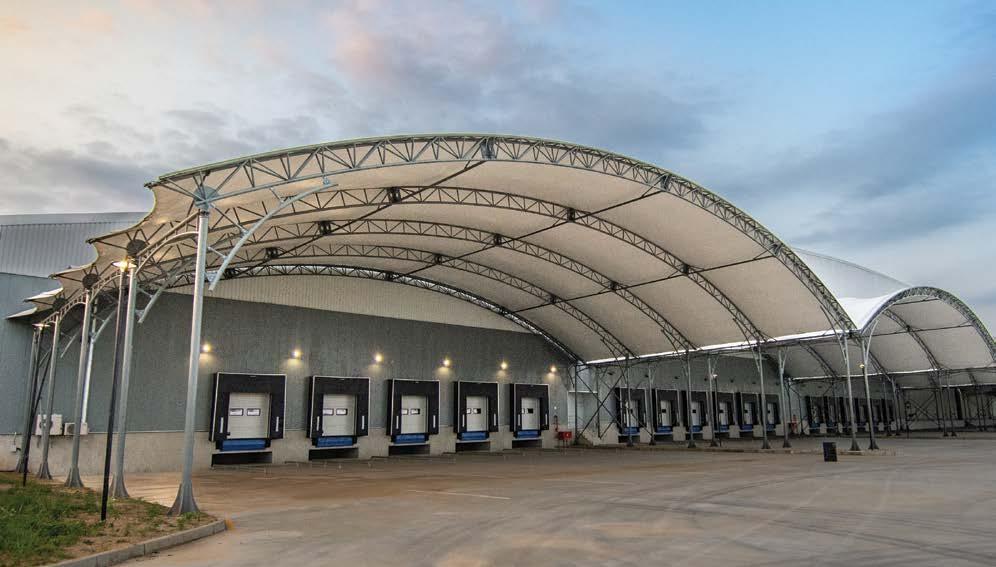
Optimisation and CAD software
According to Lemmer, the design team worked from CAD drawings and IFC models provided by the engineers, which were incorporated into the architects’ software. “The engineers did mechanical, wet services, and the concrete structure in Revit, which we then imported into our BIM model to coordinate.”
“The main challenge was the sheer size of the roof structure and its structural framing system, which posed a significant logistical challenge to transport - from the Kempton Park fabrication site to the market site over 300km away in Mbombela. To address this challenge, modular components were transported in smaller sections and then erected on site,” says Pieter-Ben van Aswegen of P-Design, the structural engineer on the project.
As such, it was imperative to ensure quite early in the fabrication process that when assembled, the full trusses would provide the correct dimensional profile to fit accurately into the roof on site.
Van Aswegen, adds that the MIFPM’s steelwork roof covers a floor area of approximately 29 000m2 (220m x 135m). “The main roof support structural system consists of a three-span, three-dimensional triangular tubular arch truss. The three spans are each 68m, resulting in maximum usable floor space below, with minimal support columns. The trusses are spaced at alternating centres of 13m and 10m. Central round, hollow section column supports are placed every 26m, with transfer trusses picking up intermediate trusses between column supports.”

PROJECT
30 winter 2024 | www.tobuild.co.za
The side end supports for the trusses take the form of supporting concrete portal frames.

Van Aswegen says the two-roof gable structures support approximately 2 200m2 of side wall cladding at each end. Designed as a separate structure and a design feat in its own right, the 16m high gable ends are supported by two-dimensional tubular pipe trusses. The steelwork roof was designed to support the loading of a 200mm thick insulated roof covering and make allowances for future solar power panel configurations.
The side end supports for the trusses take the form of supporting concrete portal frames and were integrated into the design of the building to accommodate mechanical equipment; they form the support structure for the insulated panel envelope of the building that houses insulated sectional doors that open onto the side platforms.
“Only eight internal columns for a 30 000m2 roof coverage is unprecedented”, he adds.
In the end, the entire Meccano-like roof structure was crafted and fabricated at the very capable workshops of Tass Engineering in Kempton Park, then roadhauled to the construction site, where it was bolted together on the floor and lifted into place.
Sub-structures
A vital part of the design’s adequate climate control ambitions for keeping goods fresh is a series of “white boxes” located on the main floor of the warehouse (left in the photo). There are ten cold rooms (9m high), ten pull-down rooms, and nine ripening rooms.

PROJECT
www.tobuild.co.za | winter 2024 31
'Toblerone' trusses.
About the roof and cladding
The roof is split into three equal segments for sheeting separated by gutters, with the 68m long Saflok roof sheets being rolled on site and pushed up a scaffolding ramp onto the roof. It is approximately 30 000m2 with a side cladding area of 6 200m2. It is technically classified as a white roof (high solar reflective index), in line with the selected light-coloured pre-painted AZ150 roofing and cladding material, supplied by Safal Steel and roll formed by Safintra.
"The sides of the roof consist of the 0.47 Widedek sheets with 50mm insulation, while the sides of the building have of 150mm insulated wall panels" adds Janri Lemmer.
The roof insulation panels sandwiched between two skins of profiled steel roofing material created some interest. We asked Jacques Terblanche, the Director at Orbic Architects, to explain this aspect of the design.
“The sandwich panel has two main functions: the primary function is for insulation and climatic control of the building and its contents. The highest operational temperature inside the building is within the ambient space, i.e. 14oC, and the lowest is within the cold room section, i.e. 4oC. The cost of maintaining these temperatures in the warm Lowveld and for the size of the internal spaces would be enormous, especially if measured in a thirty to forty-year lifespan. The building and spaces, as current with no ventilation and cooling being run or applied, have a constant temperature of 21o to 22oC.
“The secondary function of the sandwich panels would be to counter the ‘drumming effect’ or noise pollution during a rainstorm or hailstorm to which we are accustomed in the Lowveld. The sheer volumes and spaces within the warehouse create a vast base drum for the reverberation of sound within. That is a big problem. The sandwich panels are effective to a considerable extent in countering this noise and make for a functional and comfortable working environment.
“In addition, the lower (Widedek) skin also acts as a very ‘clean surface,’ which is part of the design to ensure that food safety standards are upheld. Very little contamination can take place within the insulation layer, and the possibility of insects nesting in the open ceiling is reduced by close to 100%.”


Architects
Main contractor
Orbic Architects
Enza Construction
Structural engineer P Design CC
Steelwork contractor
Steel detailer
Steel merchants
Contractor
Tass Engineering (Pty)Ltd
3Dstruct
Macsteel / Allied Steelrode / BSI
GSE Construction / CTK Trading
Cladding and roofing manufacturer Safal Steel
Cladding and roofing roll former/profiler Safintra
Cladding/roofing supplier
Cladding/roofing contractor
Safintra
T5 projects
The SAISC Steel Award - what impressed the judges
“Fitting all the pieces of this Meccano-like construction seamlessly and cohesively was a considerable achievement. These challenges were overcome by carefully designed jigging systems used for the fabrication of the components and then trial assembly of the major structural components and interfaces between them.
“Another impressive point is structural design engineer came up with a very elegant solution for the problem: the need for much column-free space. To solve this, an arched roof was used along the entire 220-metre length - supported at each end using a structural framing system. The aesthetics and project execution - including the engineering, the connections used, the seamlessness of it and how the structure was erected - is quite impressive and a testament to the power of structural steel as a material of construction,” said SAISC Chief Executive Officer (CEO) Amanuel Gebremeskel.
PROJECT
Balcony off the mezzanine level and traders area below.
32 winter 2024 | www.tobuild.co.za
Ten agent kiosks are positioned in a half circle inside the main entrance and embrace the public trading space.



From precision to perfection
In the industry of large format printing, precision, speed and quality are paramount. The imagePROGRAF TZ-30000 stands at the pinnacle, offering unparalleled performance to meet the demands of your business.
Experience a new era of printing efficiency and excellence with the following benefits:
Boost Productivity: experience lightning-fast printing up to 4ppm.
Minimise Downtime: keep your operations running smoothly with Canon’s unique hot swap media rolls and ink tanks.
Seamless Handling: Stacker capable of handling up to 100 pages of A0 CAD or mixed sizes.
Simplify Workflow: streamline your printing processes with smart processing software.
Elevate Quality: impress with stunning, water-resistant prints boasting vivid colours and high precision, enhancing the impact of your work.
Invest in the imagePROGRAF TZ-30000 and unlock the power of precision printing. Elevate your business with unmatched productivity and quality.
Scan the QR code to book your demo. Scan
QR code for more product information.
the

Dećor reigns
supreme at sensitive eco-tourism development
The Waterberg area, situated in the Bushveld district of Limpopo Province, is a conservation stronghold and an important UNESCO-declared biosphere reserve. The South African National Biodiversity Institute (SANBI) has also named it a critical biodiversity area.
PROJECT
Newmark Hotels, Shaun Gibson Photos & Ryan Enslin
34 winter 2024 | www.tobuild.co.za
Gareth Griffiths


Eco-sensitive development is nonnegotiable in this ecologically precious zone, and it is heartening to hear of a new tourism development involving reimagining existing buildings that seems to tick all the right boxes.
Recently, a reserve boasting the Big 5 in this malaria-free region opened its doors to the public, offering visitors an authentic and bespoke African bushveld experience. Qwabi, meaning ‘African Wild Cat’ in the Sesotho language, is an 11 000-hectare private game reserve, once agricultural land, that has since been thoughtfully rewilded, with more species being introduced regularly, say the operators.
An intensely focused genetic management programme has been embarked upon, bringing in healthy black-maned lions from a Kalahari bloodline and elephants from bloodlines that carry large tusks, to name a few examples.
“Qwabi is an extraordinary slice of the African bushveld. My team and I are very privileged to have been appointed as co-custodians of Qwabi and to turn the reserve into a world-class destination,” says Neil Markovitz, the CEO of Newmark Hotels & Reserves.
PROJECT
www.tobuild.co.za | winter 2024 35
Babohi.
To open the place to guests, the planners envisaged the creation of three distinct types of experience through the refurbishment of the existing lodges on the estate, a project almost complete:
• Letamo is a family-oriented lodge offering 58 rooms, including ten luxury rooms each with its own plunge pool.
• Babohi, a more exclusive and adultsonly lodge, has 25 rooms of different styles and offerings backed by premium experiences and facilities, fine cuisines, a presidential-style suite and other conveniences for discerning guests.
• Semela, which has yet to open, will act as an ideal venue for corporate getaways and group bookings for up to 24 guest rooms.

The planners envisaged the creation of three distinct types of experience through the refurbishment of the existing lodges on the estate


Interior design - function, meeting clients’ needs and indigenous beauty
Experienced Cape Town-based interior designer
Francois du Plessis, who has worked on several winning hospitality projects in SA and globally, believes that an essential aspect of a decorator’s job is to create an environment which is indicative of the client, project, architecture, and budget rather than place his own “stamp” on it. This approach informed his response when given the brief to design the interiors for two major lodge refurbishments in the Waterberg (Letamo and Babohi).
Du Plessis says that because his client is, in effect, “selling a luxury camp which would offer much more than a safari experience,” he planned to create an individual identity for each lodge, departing from the “generic bush look and feel”
PROJECT
Babohi.
36 winter 2024 | www.tobuild.co.za
Babohi Leopard Suite.
of the traditional game lodge. This concept also supports the relatively large sizes of the facilities, with diverse room and service offerings at a range of prices for a large number of guests.
His approach would also be functional, according to the type of guests occupying the two lodges; a “nod towards kids” for Letamo, styled with a child-friendly range
of fabrics and furnishings, the colours and textures for which are inspired by earth tones, the early Nguni People and Ndebele Art.
Babohi, the flagship offering at Qwabi Private Game Reserve, caters to adults and their older offspring aged 16+, and offers 25 five-star rooms and suites spread across four room categories, each offering serene
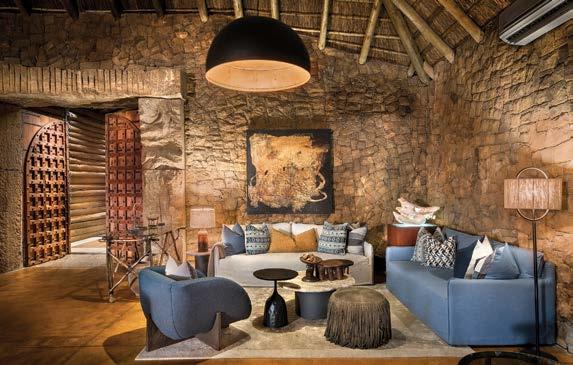
private spaces, opulent furnishings, and memorable wilderness views. Selected suites promise a range of additional indulgences, from private plunge pools to the on-trend addition of wood-fired hot tubs.
But the stand-out offering is the expansive ‘Lion’ presidential suite, which stretches to more than 150 square metres and allows for exclusive private dining and bespoke butler service on request.
According to the GM of hospitality at Qwabi, Kurt Peter: “We wanted to bring a vibrant African flair into the lodge, celebrating the colour, creativity and warmth of the continent. Throughout the rooms, suites and public areas, the décor is thoroughly contemporary but infused with a rich African influence.” Hence, Du Plessis’ design response was “earth, greens and water”, as he puts it. Babohi drew inspiration from the concept of a “royal camp” and has a theme close to the locals, namely, the formation of the Waterberg mountains, rocks, rivers and water - all signature themes of nature in the immediate environment.

PROJECT
Babohi.
www.tobuild.co.za | winter 2024 37
Babohi.
Architectural response
The project consisted of extensive reimagining and expansion of existing spaces, and the architect’s role was to work on the existing building footprint and then expand its scope and function considerably. Hence, much of the work concentrated on public areas and the expansion of luxury recreational facilities such as spas, swimming pools, gymnasiums, bomas, and bars.
According to project architect Murray Smith of Pretoria firm MSAS,"For Babohi, we expanded communal spaces, creating inviting gathering areas that retained the lodge’s intimate ambience. Letamo’s transformation, on the other hand, focused on diversifying accommodations, introducing family-friendly options alongside luxurious suites.
“Both projects integrated elements of local culture and stunning natural surroundings, inviting guests to immerse themselves in the essence of Africa. The result is a seamless transition from exclusive hideaways to inclusive havens where every guest can experience the magic of the wild.”



Both projects integrated elements of local culture and stunning natural surroundings, inviting guests to immerse themselves in the essence of Africa.
PROJECT
Letamo deluxe room.
Letamo.
38 winter 2024 | www.tobuild.co.za
Letamo.



DOES YOUR CONSTRUCTION PROJECT NEED REFINED FINISHES? We have a concrete solution for you! Contact us Tel: + 27 11 822 2320 Fax: + 27 11 822 2354 e-mail: cindy@ashak.co.za • Bonding Agents • Chemical Anchors • Concrete Bonding • Concrete Crack Repairs • Concrete Floor Repairs • Concrete Repair Mortars • Curing Compounds • Epoxy Adhesives Epoxy Grout • Floor Coatings • Joint Sealants • Non Shrink Grouts • Pre Cast Repairs • Wall Coatings • Water Proofing • 8007 Shak Construction Chemicals TO BUILD 1/2pg June’24 and more!
action needed now Construction industry:
Confidence in the construction industry has been erratic since 2020, compelling several industry players to close their doors. To Build welcomes this opinion submitted by GVK-Siya Zama CFO John de Sousa. GVK-Siya Zama is one of the largest privately owned construction companies in South Africa.
GVK John de Sousa
The companies that remain on the South African construction scene are exposed to risk, vigilante action and skills shortages due to mass emigration. However, the government’s stated commitment to making regulatory changes and spending on infrastructure does provide some light at the end of the tunnel.
The industry needs a significant boost to regain the prosperity of a decade ago. Much needs to be done to improve investor confidence and promote the sector. Here, the government has a major role to play. The finance minister’s announcements at the recent budget speech bode well for the industry - if they play out according to plan.
I am writing this opinion at a time when GVKSiya Zama (www.siyazama.co.za) marks its 30th anniversary since its inception in 1994, which coincided with the birth of democracy in South Africa. Since then, it has evolved into one of the largest privately-owned construction companies in the country.
The company’s roots, however, can be traced back to the 1960s when we operated as a painting and restoration company focused on smaller projects. Over the years, it became a significant player in the construction industry, successfully taking on larger and more complex projects.
Today, GVK-Siya Zama’s work has shifted from the highly aesthetic restoration projects of the past to being part of the construction

machinery in creating healthcare and education facilities in response to a considerable backlog underpinned by a growing and shifting population.
The advent of a democratic South Africa held much promise three decades ago, albeit with many unknowns for investors. It also presented an opportunity to address and redress inequality in terms of infrastructure and services and, along with that change, shift the emphasis on public spending.
In those early days, there was a major drive by the government to invest in infrastructure, hospitals, education facilities and the type of projects that would cement the leadership’s foothold in the country. This focus was, unfortunately, at the cost of unseen infrastructure such as pipelines and reticulation, roads, bridges, water, and electricity, challenges that the country is now having to deal with – 30 years on.

CONSTRUCTION OPINION
40 winter 2024 | www.tobuild.co.za
JohndeSousa
The government’s proposed regulatory amendments for PPPs welcomed
In my opinion, the state needs private sector participation to accelerate projects. Any relaxation of rigid structures and requirements – such as the government’s intention to amend the public-private partnership (PPP) regulatory framework – will help to reduce the procedural complexity of undertaking PPPs and contribute to more streamlined delivery of projects.
Furthermore, in the government’s recent budget speech, it announced that it plans to invest more than R943 billion in the refurbishment and maintenance of existing assets and the building of new public infrastructure. We welcome this as GVKSiya Zama. This is a promising move by the government, and we will watch the space with keen interest.
Municipalities and oversight
Our company applauds the government’s plans to transform municipalities into engines of growth through tightening budget processes, ramping up oversight, increasing the skills and capacity of municipal employees, and driving investment in maintaining and building infrastructure.
It’s no secret that municipalities have been ineffective in managing finances and delivering projects in recent years. Focusing on municipal governance and eradicating corruption and ineptitude will go a long way towards addressing these challenges.

Moving the industry forward requires decisive action
Looking at the industry as a whole, there is enormous pressure on the private sector to finance and move projects forward. On the flip side of the coin, however, there is counterpressure from labour as the government considers the privatisation of state-owned entities (SOEs). The government is in a bind. It knows what needs to be done, but dealing with these opposing forces on the ground inevitably slows the process down. Decisive action, however, is required to ensure a sustainable industry.
Economic growth, population growth, increasing unemployment and shrinking public sector spending place even the most reputable contractors in a precarious position, and present challenges to the industry’s progress. Despite these factors, GVK-Siya Zama will continue to strive towards being a sustainable company that provides employment, trains and develops employees, contributes meaningfully to the built environment and turns a profit. We will continue to carry the construction flame high and work with all stakeholders to ensure the industry’s longevity in the country.
CONSTRUCTION OPINION
www.tobuild.co.za | winter 2024 41
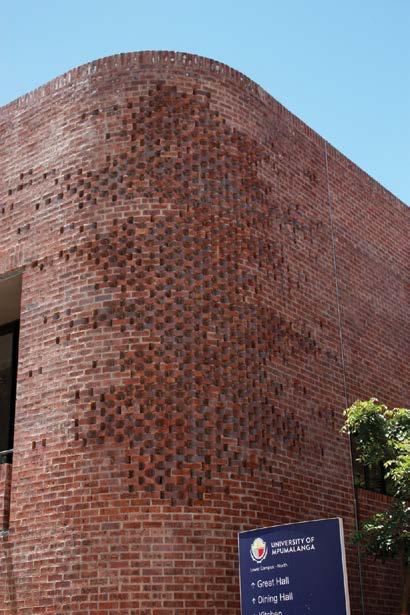




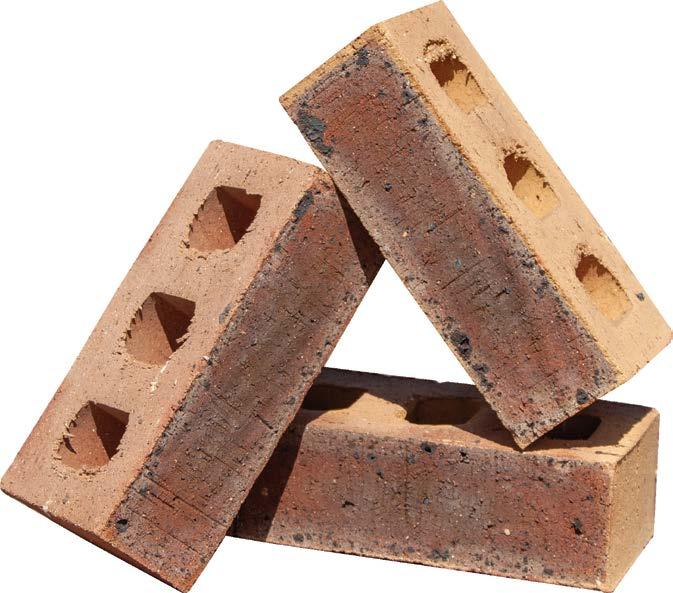

Goodbye YELLOW
brick road
In the fantasy of The Wizard of Oz, Dorothy and her friends headed down The Yellow Brick Road believing it would lead to good things. Elton John sang “Goodbye Yellow Brick Road”, an anthem to quitting the rat race of city life. There’s no mention of potholes along the way. Especially South African style!
Causes for reflective in asphalt overlays

In South Africa, we have millions of potholes on our roads to boast about, which means that every traveller has a good chance of stumbling upon at least one dip on a short jaunt in the local neighbourhood, and will certainly encounter many more during a long-distance trek. (With apologies and due credit to the Western Cape as the outlier case – Ed.)

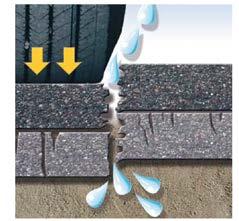
ENGINEERING
Fibertex
Fig 1. The paving fabric absorbs differential movements in the asphalt layers preventing reflective cracking. Additionally it forms a waterproof interlayer preventing surface water from entering the old asphalt layer.
Fig 2. Without paving fabric, reflective cracking of the new asphalt overlay will occus and surface water will enter the old asphalt layer. This will accelerate deterioration of the entire road construction.
44 winter 2024 | www.tobuild.co.za
Despite the goodwill of local communities who get together to attempt a quick fix, and to the municipalities that eventually fill the hole, treacherous potholes seem omnipresent all over the map. Many of them are unexpected and sometimes the only warnings during the journey sound from the calm voice of the satellite navigation ‘god’.
It’s time to turn to the professionals who know what it takes to build and fix a road or pavement that will withstand the churning of innumerous wheels and heels, for many years.
Road repair solutions
Fibertex South Africa is just such a professional company, with extensive experience in repairing the damage caused to our country’s infrastructure by vehicles or adverse weather. So we asked them for advice. The company has specific expertise in this area and specialises in a wide range of nonwovens, geosynthetics and performancebased materials.
Solutions for road construction and maintenance include the manufacture and supply of Fibertex AM-2, a flexible needlepunched nonwoven paving fabric specifically developed for road engineering conditions in Africa.
The propagation of cracks from an existing pavement onto a new asphalt/concrete overlay is a major problem for both rigid and flexible pavements alike. The resulting reflective cracking in pavements compromises the quality of a road user’s drive and ultimately the service life of the road pavement.
According to the company’s specialists, one of the leading causes of pavement deterioration is water intrusion through the pavement layer. The process of water ingress is exacerbated by cracks present on the old asphalt surface when a new asphalt overlay is installed.
“Fibertex AM-2 acts as a waterproofing membrane by substantially reducing the ability for water to move through the wearing course into the pavement,” explains Brian Potgieter, Technical Sales Engineer, Fibertex South Africa.
“The second function of the product is to slow the propagation of cracks onto the new road surface from the existing concrete or
asphalt pavement below. The membrane also acts as a Stress Absorbing Membrane Interlayer (SAMI) to prevent surface stress cracking by absorbing stresses imposed by differential loads.”
Fibertex AM-2 applications
The above system can be applied mechanically for large volume, wide-width installations, as well as in cases where narrow-width installations are required. By using Fibertex AM-2 paving fabric in road maintenance projects, maintenance cycles can be reduced, overlay thickness can be reduced; full road rehabilitation projects can be postponed and pavement life can be extended, which means substantial cost savings.
Additionally, when using Fibertex F-grade geotextiles in a basal stabilisation application below the road prism, the road design can be adjusted to decrease the thickness of load-bearing layers, while still maintaining its design load-bearing capacity. This results in a more cost-effective and less energyintensive design that ensure the durability of the pavement structure.
On the other hand, without the use of a separation fabric in weak subgrade conditions, punching of engineered aggregate into the weak subgrade could occur, as well as ingress of the below subgrade into the engineered fill material. As a result, the bearing capacity of the base course could be reduced over time, which could lead to rutting of the road surface.
Virgin polypropylene (PP) geotextiles have a high level of chemical stability over a wide pH range and are thus suitable for application in most civil engineering environmental conditions. This characteristic ensures its durability, where product failure might not only impact on project cost, but could have a long term environmental impact.
The company’s UV-stabilised, virgin PP geotextiles are the only nonwoven geotextiles produced in Africa with certification for durability of over 100 years, in accordance with the latest EN standards, advises Potgieter.
The range of environmentally friendly geosynthetic materials encompasses nonwoven and woven geotextiles, gabions and mattresses, drainage pipes and fittings and erosion control and cellular confinement solutions.
Potgieter says that the company also supplies soil reinforcement and stabilisation products, including geogrids and geocells, as well as geosynthetic clay liners (GCL) and geomembranes (GMB) that can be used as part of composite lining systems in waste containment solutions.
The company offers a technical advisory and support service to ensure correct specification of durable and safe materials for every project from branches in KwaZuluNatal, Gauteng and the Western Cape.

ENGINEERING
www.tobuild.co.za | winter 2024 45
Fibertex AM-2 paving fabric used in road surfacing projects.

Making winter a happy home-time
As winter settles in and the days become shorter, there's an undeniable shift in the atmosphere. Overcast grey skies dominate mornings, while early sunsets paint the evenings with a muted palette. Finding solace and comfort within our homes becomes paramount at this time of the year. Colour has the power to transform even the dreariest of days into moments of serenity and warmth.
Plascon
This winter, let's embrace the concept of slowing down and cherishing the simple joys of life. Inspired by the need for serenity, The Eternal Palette is a collection of soft, soothing hues designed to evoke a sense of calm and relaxation. Here's how you can incorporate these colours into your home to create a haven of tranquillity whether you live in the grey, rainy winter of Cape Town or the early-dark evenings of Gauteng.
GET IT DONE
46 winter 2024 | www.tobuild.co.za
Here are some tips for incorporating colours into your winter home:
Consider the room's function
Bedrooms naturally lend themselves to softer, sleepinducing colours, while living rooms can handle bolder accents.
Don't be afraid to experiment
Play around with paint swatches to see what combinations resonate with you.
Think beyond paint
Add touches of cosy comfort and introduce pops of colour through throw pillows, rugs, artwork, or furniture upholstery.
Embrace texture
Combine smooth surfaces with textured fabrics to add visual interest without sacrificing the calming mood.



The 60-30-10 Rule
This classic design principle can help you achieve a balanced colour scheme. Use one colour (60%) as your dominant colour, like painting your walls. Introduce a secondary colour (30%) through furniture or curtains. Finally, add vibrant accent colours (10%) with throw pillows or artwork.
Experiment with different shades and combinations to find what works best for you. With a little creativity, you can use the power of colour to chase away the winter blues and create a snug haven that feels stylish and uplifting - the perfect antidote to shorter, cooler days.
We asked leading paint supplier, Plascon, for some tips as to what will be warming South African homes and office spaces this winter into spring. The designers and technologists working in the company spend considerable time tracking and researching overseas trends that could influence the South African design scene.
GET IT DONE
www.tobuild.co.za | winter 2024 47

Some advice on trending winter colours
“This winter in South Africa, there is a move to slow down and find solace in meaningful moments with a harmonious palette of smooth transitional colours. Considering the pace at which the world is moving and the increasing political uncertainty in many countries, this mood is likely to last a good while” advises the company’s colour and design team.
Plascon advises you start by infusing your living spaces with dusky hues that exude elegance and warmth. Consider pairing their Grey Archo (P1E1-3) with Fragrant Flower (B7-D1-4) in bedrooms to create an ambience perfect for de-stressing after a long day. Let the gentle beauty of Terra Nova (R6-D1-2) grace your hallways, offering a welcoming embrace as you step through the door. Explore the realm of serene purples to cultivate a feeling of peace and tranquillity. Cloud Number Nine (B6-A2-3) and Smoke Bush (P4-E23) form a delicate pair ideal for creating leisurely retreats in bedrooms or cosy reading nooks. For a touch of sophistication, blend these purples with Fragrant Flower (B7-D1-4) and Grey Archo (P1-E1-3) in living areas, infusing the space with a sense of quiet elegance. Warm neutrals provide the perfect backdrop for moments of reflection and reassurance. Ravine (62), Wilted Leaf (31) and Stuffing (36) envelop your home in a comforting embrace, inviting you to let go and unwind. If you crave a touch more drama, consider adding a grounding pop of colour with the deep red, Terra Nova (R6-D1-2), anchoring the space with its deeply shaded richness.

These colour suggestions are just a starting point. The supplier recommends experimentation and researching the options for your own warm and motivating space.
Interested readers looking for advice are welcome to email the team on: ColourAdvice@kansaiplascon.co.za
GET IT DONE
48 winter 2024 | www.tobuild.co.za



Luxury home trendswhat’s new?
Home trends in the luxury market help set the standard for the broader real estate landscape and influence design preferences, consumer expectations, and market dynamics across all segments, suggests a leading South African realtor.
Lew Geffen Sotheby’s
As luxury properties set new standards for innovation, quality, and lifestyle amenities, this trickles down to the general market, shaping buyer preferences and driving demand for upscale features and finishes.
We asked Yael Geffen, CEO of Lew Geffen Sotheby’s International Realty to share her views: “In real estate, luxury homes are the epitome of aspirational living, a status symbol and in this ever-evolving realm of exclusivity, discerning homeowners and visionary designers continually redefine the notion of luxury living.”
From island villas to sleek urban estates, luxury homes are the epitome of refined living, carefully designed to showcase prominence and cater to affluent homeowners’ tastes and needs. Architects and designers constantly introduce innovative materials and state-of-the-art technologies to meet the needs of these discerning customers. In more recent times, social and environmental consciousness has also played a significant role, edging the trend towards eco-friendly materials and energy-efficient designs. At the same time, the influence of global culture and travel
inspires aesthetic and functional elements that reflect a cosmopolitan lifestyle, she opines.
According to Geffen, several key trends have emerged in luxury real estate. Here are the top five luxury home trends shaping the market in 2024.
discerning homeowners and visionary designers continually redefine the notion of luxury living.
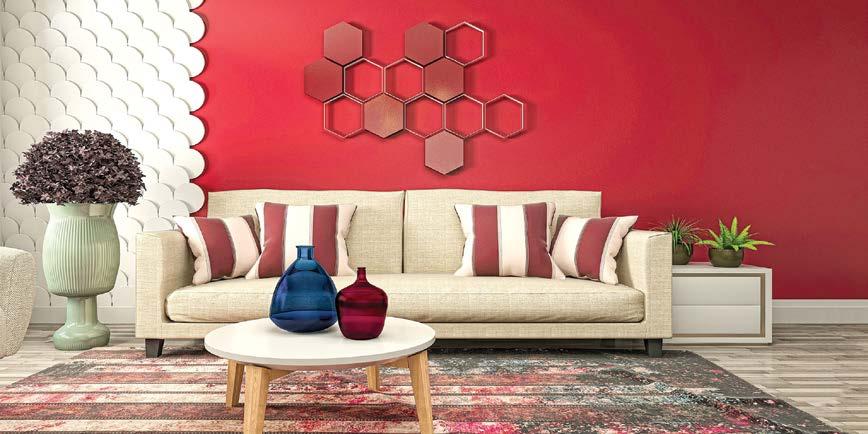
GET IT DONE
50 winter 2024 | www.tobuild.co.za
Customisation and personalisation
In 2024, luxury properties offer customisable features and finishes, allowing homeowners to express their individuality and create personalised living spaces that reflect their tastes, interests, and aspirations. From custombuilt cabinetry and millwork to bespoke furnishings and artwork, every aspect of the home is carefully curated to align with the homeowner’s vision and reflect personal style.
Timeless and traditional elegance
2024 also revives timeless and traditional designs beyond modern trends and fads: antique decor, intricate mouldings, statement heirloom pieces, rustic accents, grand proportions, and symmetrical façades blended within stylish spaces to create harmony between old and new. These elegant and sophisticated designs honour traditional architectural techniques and aesthetics that transcend time and ensure lasting value.

Quiet luxury
This trend emphasises classic investment pieces that you can build a room around. Timeless pieces in classic shapes and silhouettes can have many lives and evolve through reupholstery. Luxurious, soft, textured fabrics, warm, rich woods, and quieter patterns for large furniture will reign supreme.

GET IT DONE
www.tobuild.co.za | winter 2024 51
Bespoke artistry as the focal point
Nowadays, luxury homes also serve as a canvas for artistic expression, originality, and creativity. Aesthetic pieces like custom-made furniture, handcrafted decors, colourful murals, unique sculptures, and striking paintings can be infused into a luxury residence’s design to transform it into an immersive environment that goes beyond a mere living space – one that reflects the distinctive tastes and characteristics of the homeowners.
Embracing the artisan – there’s been a movement to celebrate handmade and unique pieces.


Use of innovative materials
Now is the time to push the boundaries of interior design and architecture. Using unconventional materials with innovative applications, such as seaweed and paper furniture, composite stone walls, 3D-printed decor, and even nanotech finishes, would be a great way to add uniqueness without sacrificing functionality.
Also, futuristic materials - contemporary pieces and fixtures developed with innovative materials, like recycled plastics and fibres grown from fungi, will continue to break through the noise.
What’s out?
While many existing trends will endure for some time, Geffen says that the experts have deemed that the following are definitely out this year.
• Minimalism
2024 is the year to banish sterile environments and embrace things that reflect you and your passions. Layer up with textures, textiles, and styles.
• All-white kitchens
The all-white cabinetry is giving way to colour – every shade of green is in vogue, along with pastel shades and bold blues. 2024 will see more colour, more adventurous choices, and bolder kitchens that feel more like living rooms than kitchens.
• Fast furniture
Homeowners are growing weary of mass-produced furniture that quickly falls apart or looks generic and dated – and yes, that includes Ikea. Originality is the way to go.
• Instagram design concepts
Design ideas copied from Instagram and Pinterest are regarded as the equivalent of stage set design in a year where innovation is the watchword.
There will be an emphasis on unique finds and curated spaces rather than replicating what you see from others online.

52 winter 2024 | www.tobuild.co.za GET IT DONE
Yael Geffen, CEO of Lew Geffen Sotheby’s International Realty




home
have street appeal? Does your
In an era when the cost of living continues to rise, finding budget-friendly ways to enhance our living spaces has become more crucial than ever. We often overlook one aspect that significantly impacts our home’s appeal – the kerbside and front entrance. The exterior is more important because it’s what people see when they first arrive.
Contrary to popular belief, elevating the aesthetics of these areas does not have to drain your wallet. With a bit of creativity, some DIY spirit, and strategic choices, you can transform the entrance to your home into a welcoming, attractive space without breaking the bank.
Gareth Griffiths
A splash of colour
Never underestimate the power of paint. A vibrant front door can become a focal point, welcoming guests with a burst of personality. Choose a colour that complements your home’s exterior but stands out enough to make a statement. Similarly, updating window trims, shutters, or the mailbox with a new hue can significantly enhance the overall look without requiring a substantial investment. For those who love changing themes with the seasons, consider using removable decals or temporary paint options for a fun and flexible approach.

Repurpose and reimagine
The first step to a budget-friendly kerbside makeover is to look around your home for items that can be repurposed. Old furniture, such as chairs or tables, can be refurbished with a fresh coat of weather-resistant paint and used as unique plant stands or decorative elements. Wooden pallets from local stores, often available free or at a low cost, can be transformed into charming vertical gardens, signage, or even a quaint bench. The key is to see potential in items that may otherwise be considered for trash or donations.

IMPROVEMENTS & MAKEOVERS DIY
54 winter 2024 | www.tobuild.co.za
Landscape with perennials and indigenous plants
It’s not always expensive when you focus on planting perennials and indigenous plants. It also reduces both cost and maintenance. Perennials return year after year, providing consistent beauty with a one-time investment. Indigenous are adapted to the local climate and soil, requiring less water and care than the exotics. Try incorporating these into your garden beds or as potted arrangements by the entrance, creating an inviting natural environment that grows richer each year.

Tap into community resources and the sharing economy
Community recycling and repurposing resources such as plant swaps, garage sales, and local online marketplaces can provide both materials and inspiration. Ask your neighbour if they can share plant cuttings or excess gardening materials or even lend you tools for your projects. This not only cuts costs but also fosters a sense of community and shared purpose.


DIY décor and lighting
Decorative elements and lighting are crucial in setting the tone for your front entrance. In the evenings, try crafting outdoor lanterns from recycled canning jars or tin cans to add a charming glow to your entrance.
Solar-powered options can save on energy costs and electrician’s fees. Remember the “solar jar”?
Handmade wreaths, door signs, and seasonal decorations can reflect your personality and are a fun project to tackle alone or with family.
Walkways on a budget

The walkway introduces your space, guiding guests to your doorstep. Do this cost-effectively. Add a few creative touches and some elbow grease and turn your ordinary walkway into an enchanting journey that boosts your home’s curb appeal.
Consider using salvaged materials to create or edge your walkway. Bricks, stones, and pavers can often be found for little or no cost from renovation sites or community giveaways. Laying these materials in unique patterns or interspersing them with ground cover plants like creeping thyme or moss adds charm and character. Not only does this approach save money, but it also contributes to sustainability by repurposing items that might otherwise end up in a landfill.
IMPROVEMENTS & MAKEOVERS DIY
www.tobuild.co.za | winter 2024 55

Natural borders
For an inviting, lush walkway, consider planting a border of low-growing shrubs, perennial flowers, or ornamental grasses. Use plants appropriate for your climate and the amount of sunlight the area receives to ensure they thrive with minimal upkeep.
Finally, illuminating your walkway enhances safety and adds an enchanting aesthetic quality. Solar-powered lights are an economical and environmentally friendly option, as mentioned above. You can also consider string lights overhead or lanterns hung from shepherd’s hooks.
With creative repurposing, DIY projects, and thoughtful plant choices, you can create a welcoming and attractive approach to your home.
These enhancements not only elevate the aesthetic appeal of your entrance but also increase the functionality and safety of the path to your doorstep.
DIY stepping stones
Creating your own stepping stones is fun and adds a personal touch to your walkway. Mix concrete and pour it into moulds, using anything from store-bought shapes to homemade ones crafted from cardboard boxes or old pans. Embed stones, shells, glass fragments, or handprints for a custom look. This allows for endless creativity, enabling you to match your home’s exterior style and colour scheme. In South Africa, pine rings (stepping stones) culled from the thick trunks of pine and other alien trees can work a charm. (Do watch out for infestation by beetles in the wood, however, before cutting them, especially by the Polyphagous Shothole Borer - see greenpop.org/polyphagous-shot-https:// hole-borer/).

56 winter 2024 | www.tobuild.co.za IMPROVEMENTS & MAKEOVERS DIY









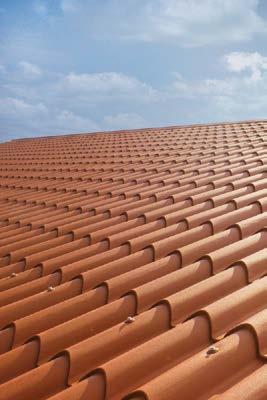









































































































A complete range of waterproofing products, providing solutions for both commercial and domestic use.




WWW.MEDALPAINTS.CO.ZA MEDALPAINTSSA 0860 063 325 THE GO-TO PAINT FOR ALL SURFACES.
HIGH QUALITY
HIGH VALUE
.
.
lighting right indoors –
GET THE expert advice

It is at times such as the onset of winter that interior lighting assumes critical importance. The much shorter days mean rising in the dark and getting home in the dark. It’s also a time when cold weather and a lack of adequate sunshine mean our stressbusting hormone, serotonin, is at its lowest ebb.
In summer, when we revel in 14 hours or more of sunlight, exposure to it is thought to increase the brain’s release of serotonin. Credible research has demonstrated the importance of sunshine in our daily lives. So, what can we do to beat the nighttime depression routine, known as Seasonal Affective Disorder in winter?
We spoke to interior design expert, Kim Williams (www. kimwilliams.co.za), about the role that lighting can have in keeping you happy at home.
“Lighting greatly impacts our well-being. Warm tones create a calming atmosphere for evening relaxation, while task lighting ensures safety and functionality for activities like braaiing,” Kim advises.
IMPROVEMENTS & MAKEOVERS
Framed by Claire & Kendall-Leigh Nash
Kim Williams & Gareth Griffiths
58 winter 2024 | www.tobuild.co.za
A
Claremont new build and Kenilworth projects by Kim Williams illustrate her approach to lighting.
“Lighting goes beyond ambience. It's a spotlight for your well-being. To make the most of lighting indoors, consider using a combination of different types of lighting such as ambient, task, and accent lighting,” she adds.
Before venturing into a project, it’s essential to understand the different roles of lighting indoors:
• Ambient lighting provides overall illumination and sets the tone for the room.
• Task lighting is focused on specific areas where activities are performed, such as reading or cooking.
• Accent lighting, on the other hand, highlights particular features like artwork or architectural details.
By strategically layering these various types of lighting, you can create a dynamic and visually appealing space that looks great and functions well. According to Kim, dimmer switches are a great tool that lets you quickly adjust the light intensity from bright to warm glow.
“Dimmer switches are like a magic wand, letting you adjust the mood from energising to intimate. The power of lighting goes beyond function. It adds depth, drama, and a touch of the unexpected. It can spotlight artwork, highlight architectural details,
or make decorative elements shine,” she enthuses.
“Lighting can even be a work of art. Statement chandeliers or stylish lamps add a touch of elegance to a room’s design”.

Natural lighting aces all else
“Natural light is the ultimate mood booster, open spaces bathed in sunlight create a sense of connection to the outdoors and promote feelings of calm and energy”.

IMPROVEMENTS & MAKEOVERS
www.tobuild.co.za | winter 2024 59


...in interior design, lighting plays a crucial role in enhancing the colour scheme of space and transforming flat spaces into phenomenal spaces.
So how does it work?
Lighting is crucial in interior and exterior spaces, especially outdoor entertainment areas. The right touches can transform an outdoor space from basic to breathtaking.
Proper lighting enhances the space’s functionality by ensuring safety and visibility and contributes significantly to the wellbeing and mood of the people using the area.
Soft ambient lighting creates a cosy atmosphere for conversation, while accent lighting can make architectural features or landscaping stand out dramatically.
Coloured lighting and dynamic effects can turn your patio into a party zone for special occasions. Imagine setting the mood for a festive summer braai with twinkling fairy lights or a vibrant pool party with colourchanging effects.
Kim’s hot tip
By layering different lighting types - ambient, task, and accent - and incorporating natural light, you can create a dynamic and functional lighting design that makes you feel good and your space shine.
So, in interior design, lighting plays a crucial role in enhancing the colour scheme of space and transforming flat spaces into phenomenal spaces.
Using a combination of different light fixtures such as overhead, floor, table, and wall sconces, you can layer the lighting in a room to highlight specific colours and textures. Warm tones like reds and oranges come alive under soft, inviting light, while cool blues and purples pop with a touch of crispness.
We are fortunate to have the regular advice of Kim Williams on our pages. If you would like to follow her, do check her out on Instagram as @kim_williams_design where she is an active influencer. If you have a question, email media@kimwilliams.co.za and do mention you read about her in TO BUILD!
IMPROVEMENTS & MAKEOVERS
60 winter 2024 | www.tobuild.co.za

pantry ABOUT THAT you wanted


IMPROVEMENTS & MAKEOVERS
KSA
Stephanie Forbes, Kitchen Specialists Association (KSA)
62 winter 2024 | www.tobuild.co.za


With the colder weather closing in, we all get hit with that nesting instinct – to stock up and hibernate, ensuring the pantry is fully stocked so we only have to brace for the cold when necessary. So, we can think of no better time to reflect on the kitchen pantry space and how it has evolved over the years.
Regardless of your kitchen size, you most likely have a pantry of some sort in your home. This might be just a shelf in a cupboard or a whole walk-in cupboard. As kitchens have evolved, the humble kitchen pantry has become an almost indispensable addition to many kitchens. Most homeowners currently put the kitchen pantry on their “wants” list. It’s not hard to see why. Whatever the size of your kitchen space, you’ll always need a convenient place to store your groceries. This critical storage requires careful thought and planning. The evolution of the pantry space is an interesting reflection of what has happened over the years socially, economically and architecturally.
The word “pantry” comes from the Old French term “paneterie.” Homes in the late Middle Ages would have had a room where bread and meat were stored. In the latter part of the 19th century, middle-class English or American homes often had pantries built adjoining the kitchen and dining room. Large houses in Victorian Britain often had pantries that were separate rooms dedicated to food preparation and clean-up.
Over the years, we have seen many different types of pantries. The butler’s pantry was a walk-in style pantry (becoming popular again now). It was usually a combination of cabinet space, open shelving, and counter space. They were typically placed adjacent to the kitchen and used to store valuable glassware, dishes and silverware, and the space was usually managed by the household butler. Recently, this design has been adapted to accommodate small appliances or is tailored to cooking hobbies or passions, like baking.
The fridge and freezer have long since replaced the cold pantry, but this was a room designed and built to keep foodstuffs
fresh. It consisted of a cabinet with wooden slat shelves to allow air circulation and was usually built on the north (coolest) side of the house.
The Hoosier cabinet was one of the first portable pantries. It was developed in New Castle, Indiana, in the early years of the 19th century, and remained popular into the 1930s. It was built to serve two rooms in one – the pantry and kitchen. It contained a big storage space and working counter and soon became essential in the American kitchen.
For modern homes, various versions of the butler’s pantry and Hoosier cabinet are adapted as part of a contemporary kitchen. In the 1980s, transforming the cumbersome corner cupboard into a pantry with criss-cross shelving was a great way to maximise space and storage. Modern-day door solutions like pocket doors and wing doors have allowed pantry-style spaces to be adapted for bespoke tea or coffee stations or specialised baking cupboards. Here, the doors fold back, revealing the pantry-style unit, and close to hide it once more from view.
With modern living becoming more compact, a purpose-built pantry is not available to all. However, we have seen the hardware industry step up to offer clever, ergonomic solutions to the much-needed storage space. The ‘space tower’, ‘pull out pantry’, and ‘corner pantry pull’ are just a few of the ingenious modern inventions we have seen on the market that offer consumers the versatility of a pantry when they don’t have the space. Drawer inserts and pull-out spice racks also help give the modern kitchen the versatile storage space traditionally offered by the pantry.
So, how do we design the perfect pantry? It should be large enough to hold at least a week’s worth of groceries and be easily accessible from the food preparation area. Size matters, of course, but with the right combination of simplicity, organisation, and location, you can easily create a pantry that is as functional as a full-size walk-in. A good kitchen designer will know about our KSA hardware suppliers’ various offerings to suit your space, lifestyle and pocket.
IMPROVEMENTS & MAKEOVERS
www.tobuild.co.za | winter 2024 63
The
Convenience: located at or near the food preparation area.
Reach-in pantries
Reach-in pantries are shallow cabinet-style pantries where the goods are stored on shelves that aren’t too deep. Deep pantries, of course, hold more goods, but installing deeper shelves is a common mistake. Inevitably, things you use frequently get pushed to the back as you add new items to the shelves from your most recent shop, so you end up having to move items around to find the one you want. This is clearly impractical.
An alternative to a Reach-In pantry would be a “Tandem” internal pull-out accessory where there are internal shelves in the cupboard unit and shelves attached to the door so that when one opens the door, the internal shelves move in tandem with the door shelves bringing your grocery items closer to you.
Visibility: everything should be seen at a glance.
Pull-out pantries
A pull-out pantry is a series of “stacked” shelves that slide from outside the unit. The shelf stack is attached to the unit door. Shelves can be accessed from both sides, which helps it tick the accessibility box well. The height between the shelves is also adjustable. While not quite as convenient as a tandem or reach-in pantry, the pull-out pantry is a good option if your kitchen space is restricted.
Accessibility: it should be possible to remove items without moving others around.
Walk-in pantries
As the name suggests, a walk-in pantry is a small room or cupboard dedicated to food storage. For many homeowners, this is the ultimate pantry and, unfortunately, a dream for apartment dwellers. A walk-in is an excellent choice for storing large quantities of goods, particularly if you have a large family and are bulk buying. One drawback is that if the pantry is too big, it could become inconvenient to use daily. In this case, a smaller pantry or shelf is recommended closer to the prep area to stock often-used items that need to stay close at hand.
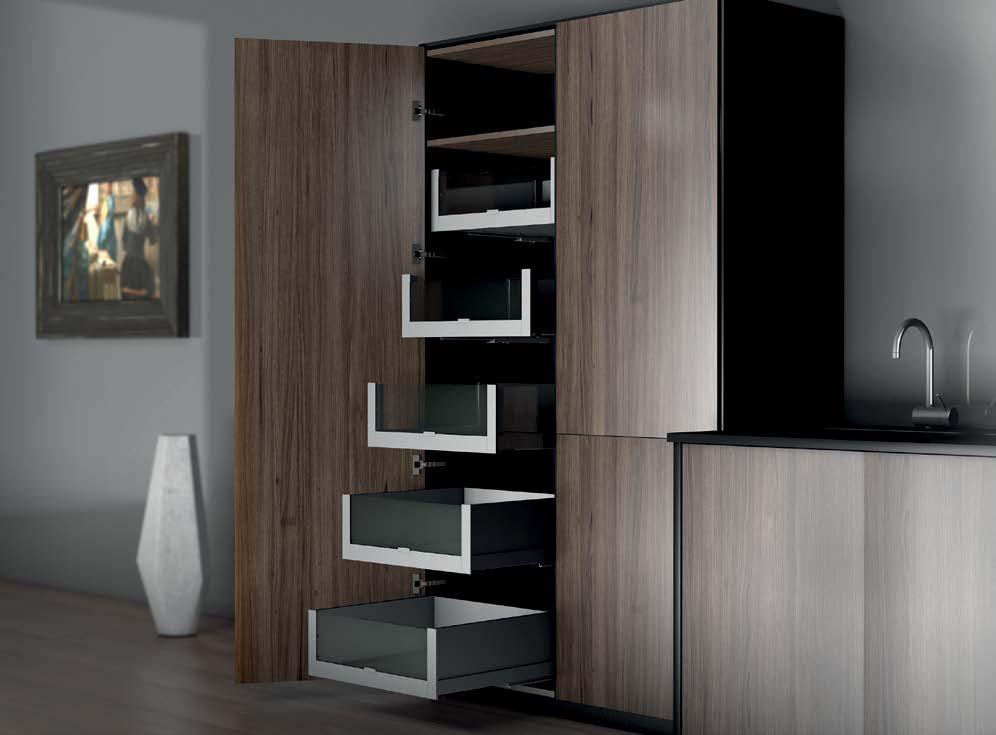
Whatever you opt for, there is no doubt that the pantry space is now synonymous with the modern kitchen. Whether you achieve it through modern space organisers or through a traditional walk-in space, the kitchen pantry is here to stay.
IMPROVEMENTS & MAKEOVERS
The most popular pantries available to homeowners today are as follows.
key characteristics of a practical pantry are:
64 winter 2024 | www.tobuild.co.za









Get inspired for your next project with Gyproc Contact our team for assistance
Transforming living spaces:
Gyproc's innovative solutions for visual, thermal, and acoustic comfort in South African homes
In the dynamic landscape of home construction and design, the quest for comfort and well-being remains a top priority for homeowners, contractors, and building occupants. In this search for the ideal living space, Gyproc emerges as a trailblazer, offering transformative possibilities that go beyond the conventional norms. Their innovative solutions focus on prioritising your visual, thermal, and acoustic comfort, making your world a better home.
Visual comfort
Gyproc products are synonymous with elevating the visual aesthetics of living spaces. Homeowners in South Africa can now explore a myriad of design possibilities that combine functionality with style. Gyproc's extensive range of ceilings allows for versatile customisation, enabling homeowners to create unique and visually appealing interiors.
Their innovative products open doors to features such as curved walls, recessed lighting designs, and intricate architectural details. Whether it's a modern urban apartment or a traditional suburban home, Gyproc empowers homeowners to turn their design aspirations into reality, enhancing the visual appeal of their living spaces.
Gyproc products that enhance visual comfort:
• Gyproc RhinoLite® plaster for smooth and crack-free surfaces creating aesthetically pleasing spaces.
• Gyproc QuickCornice™ range of decorative products for ceilings, turning any room into a décor masterpiece.
• Gyproc Rhinoboard® achieves bespoke spaces with ceilings and walls to meet architectural design intents.



ADVERTORIAL 66 winter 2024 | www.tobuild.co.za
SCAN NOW for more information
Thermal Comfort
As we typically spend more than 90% of our day indoors, the buildings we live and work in have a huge potential to affect our health and sense of wellness. South Africa's diverse climate demands innovative solutions for thermal comfort within homes and buildings. Gyproc addresses this need with cutting-edge thermal insulation products that contribute to energy efficiency and a more sustainable living environment.
Their solutions act as a barrier against external temperature fluctuations, ensuring that indoor spaces remain cool in the scorching summer months and warm during chilly winters. By investing in Gyproc's thermal solutions, homeowners not only enhance their comfort but also contribute to reducing energy consumption and lowering utility costs.
Gyproc products that enhance thermal comfort:
• Gyproc Rhinoboard® supports a comfortable internal environment.
• Isover Aerolite® Soft Touch and Cavitybatt™ insulation with thermal properties limit the impact of the outside temperature variations, helping to maintain a stable and comfortable living environment.

Acoustic Comfort
In today’s world, tranquillity is a rare luxury that Gyproc has taken significant steps towards fostering through acoustic comfort within homes and commercial buildings. Their acoustic solutions effectively mitigate noise pollution, providing a serene and peaceful living environment for occupants.

Whether it's the hustle and bustle of urban life or the desire for a quiet home office space, Gyproc's acoustic plasterboards and sound insulation materials create a haven of calmness. Contractors can confidently recommend these solutions, knowing that Gyproc's products offer not just visual and thermal comfort, but also a sanctuary from the cacophony of the outside world.
Gyproc products that enhance acoustic comfort:
• Gyproc RhinoBoard® SoundBloc® is an effective way to block sound in busy, noisy places and create serene, soundbuffered zones of tranquillity where it matters most.
• Gyproc perforated gypsum ceilings offer acoustic performance which helps with sound.
• Isover Aerolite® Soft Touch and Cavitybatt™ insulation with acoustic
properties can also be used to control noise by absorbing sound and reducing reverberation time allowing you to enjoy the full benefits of surround sound systems.
Gyproc stands at the forefront of innovation, offering a comprehensive suite of products that redefine the possibilities for visual, thermal, and acoustic comfort in South African homes and buildings. By prioritising the well-being of occupants and incorporating these transformative solutions, Gyproc cements its position as a trusted partner in the journey of creating living spaces that seamlessly blend aesthetics with functionality, while at the same time focusing on environmental sustainability.
As homeowners, contractors, and building occupants explore the vast potential within Gyproc's product range, they not only elevate the quality of their living spaces but also contribute to the broader narrative of sustainable and comfortable construction practices. Gyproc stands as a beacon of innovation, inspiring a new era of homes and buildings where comfort and well-being take centre stage.
www.tobuild.co.za | winter 2024 67
ADVERTORIAL
Heating your home in winter:
the South African dilemma
Did you know, a 300m² house with reasonably good insulation will require about 10 000 KwHrs of energy to maintain a comfortable 20 -22 C temperature over a 4 month Highveld winter period?
A comparison of energy costs for 10 000 KwHrs of energy
Open flued gas fire
Under floor electrical heating
Electrical heaters
Flue-less gas fires
Open wood fires
Air conditioners
Closed combustion wood stove
R100K Huge heat loss via perpetually open chimney.
R40K Requires electricity to operate.
R33K Requires electricity to operate.
R30K Great heaters for use in open plan living areas.
R28K Huge heat loss via perpetually open chimney.
R15K Requires electricity to operate.
R4K Economical, environmentally friendly heating.
Apart from the financial costs of using electricity for home heating and the burden of load shedding, using 10 000 KwHrs of electricity would entail Eskom burning 4 tons of coal and consuming 200 000 litres of water (roughly 3 swimming pools) in the making of this electricity, creating significant air pollution and straining South Africa’s water supply.
Closed Combustion Wood Stoves (CCWS) are recognised globally for their efficiency and environmental friendliness in home heating. Wood burnt in these units reaches a combustion temperature in excess of 900°C. At these temperatures wood is burnt at nearly 80% efficiency, wasting very little in the way of heat into the atmosphere.
Flue emissions from wood burnt in a good quality CCWS are less than if the wood had rotted naturally in the forest. If you are growing trees and burning the excess/dead wood, your contribution towards global warming is nil from using your CCWS.

The cost of buying and installing a decent quality CCWS is generally recouped in about 2 years through savings on your energy bills.
Aside from the economics and environment benefits of CCWS , these units are remarkably easy to light. They use a minimal amount of wood, probably requiring 2 or 3 loadings of wood per evening. With the air controls fully open and the unit full of lit wood, they are powerful heaters, quickly moving heat across open-plan living areas. Leave them burning overnight, with a full load of wood and the air controls at slow setting, and these units can burn for 6 to 12 hours, keeping your home warm till you get up in the morning.
Assuming you purchase a CCWS with a good-size glass, the visual effects of these flames burning slowly are mesmerising and very conducive to sitting around and chatting/relaxing.
Infiniti Fires has in 2024 added new model wood stoves to its existing range, with several of these being economy models designed to heat 80 -120 m² spaces. " This is sufficient to heat a good size living area, or more of the home in many smaller houses. Using the technology developed over the last 15 years in our older wood stove models, these newcomers to our range provide good heating capacity and energy efficiency, as well as stylish modern looks.
www.infinitifires.co.za

ADVERTORIAL
68 winter 2024 | www.tobuild.co.za
EFFICIENT & STYLISH HEATING & BRAAI SOLUTIONS WITH MINIMAL ENVIRONMENTAL IMPACT


Visit www.infinitifires.co.za to view our extensive range of gas fires, wood stoves & braais
THIS WINTER:
fireplaces
This winter we talk modern trends in fireplacesboth indoor and outdoor fireplaces.

Modern trends in fireplaces - indoor and outdoor fireplaces. Today's fireplace designs seamlessly combine aesthetics with functionality, bringing warmth and style to homes. To Build dives into the latest trends defining the contemporary fireplace industry.
FIREPLACES
70 winter 2024 | www.tobuild.co.za
Gareth Griffiths
Indoor fireplace trends
Ethanol is ubiquitous, especially in countries such as SA, which have sugarcane. The shift towards sustainability has made ethanol and electric fireplaces increasingly popular in modern homes. These fireplaces burn clean, are easy to install as they don’t require a chimney, and can be used in various settings within the home.
On the other hand, electric fireplaces offer convenience and safety, with realistic flame effects and the ability to operate without heat if desired. Of course, loadshedding is always the unknown factor.
Both options are favoured in urban apartments, however, where safety, space, and air quality concerns are paramount if not entrenched in the orders of the corporate body.
Minimalist designs

Multi-sided fireplaces
Minimalism continues to dominate interior design, and fireplaces are no exception. Contemporary fireplaces often feature simple, sleek lines with little to no ornamentation. Frameless glass fronts and slim, geometric shapes allow these fireplaces to blend seamlessly with any modern décor. Materials like polished concrete, stainless steel, and black matte finishes enhance the minimalist aesthetic while maintaining a sophisticated look.

Multi-sided fireplaces are a central feature that can be enjoyed in multiple rooms. This design maximises functionality and enhances the visual connection between spaces in an open floor plan. Whether a two-sided model seen from a living room and dining area or a more complex threesided design, they can add a dramatic touch while distributing warmth efficiently throughout the surrounding areas. Here, one thinks of fireplaces that divide living rooms from dining areas.
Smart technology integration
With the rise of smart home technology, it was only a matter of time before fireplaces became smarter. Many modern fireplaces can now be controlled via smartphone apps, allowing users to adjust flame size, temperature, and even lighting with the touch of a button. This trend offers unprecedented convenience and control, making creating the perfect ambience for any occasion easier.
FIREPLACES
www.tobuild.co.za | winter 2024 71

Fire pits and fire tables
Outdoor living spaces have evolved into extensions of the indoor living area, with comfortable seating and cooking facilities. Fire pits and tables are central to this trend, providing warmth and a communal space to gather around. These features range from portable models to custombuilt units that complement the outdoor décor, incorporating materials such as natural stone, copper, and weather-resistant metals.
Eco-friendly and portable options
Similar to their indoor counterparts, outdoor fireplaces are also embracing eco-friendly trends. Portable wood-burning fire pits and bowls are popular for their traditional appeal and mobility, allowing them to be moved as needed within outdoor spaces. However, LPG-fired options offer a cleaner burn with less smoke, ideal for areas where air quality or space constraints are a concern.
Integrated outdoor fireplace walls
One of the more striking trends in outdoor fireplace design is the integration of fireplaces into structural elements of the garden or patio, such as walls or custombuilt columns. These built-in fireplaces add a unique aesthetic element and help define different outdoor living space areas, like dining and lounging areas. They often feature expansive cooking areas and functional chimneys that can incorporate weatherproof outdoor dećor.
Outdoor fireplace trends

Multi-functional designs
Outdoor fireplaces are increasingly designed to serve multiple functions. Many models now include built-in grilling surfaces or pizza ovens, enhancing outdoor entertainment possibilities. This trend reflects a broader movement towards maximising the utility of outdoor spaces, turning them into versatile areas for cooking, socialising, and relaxing.
The modern fireplace is evolving, emphasising clean, sustainable energy use, minimalist aesthetics, and multi-functional features. As technology and design tastes evolve, so too do the ways in which fireplaces enhance and complement contemporary living spaces. These trends reflect changes in design preferences and lifestyle, offering new ways to enjoy the comfort and warmth that fireplaces bring to homes.
72 winter 2024 | www.tobuild.co.za FIREPLACES


An incredible variety of premier-quality fireplaces
As a wood-burning fireplace specialist, Faitsch Products takes pride in importing and distributing the highest quality wood-burning fireplaces from some of the best manufacturers in the world. This assures Faitsch customers will receive the best advice, quality and design available.
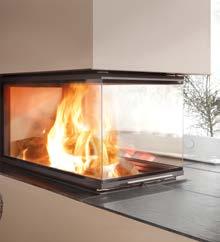
Brunner, Spartherm (winner of the German Design Award 2016) and Wamsler fireplaces fulfil the highest German, Austrian and Swiss environmental requirements and Faitsch Products is the exclusive importer and distributor of these brands for Southern Africa.

The Faitsch Products showroom in Somerset West offers over 100 different models to choose from.
When combined, Faitsch Products’ manufacturers offer more than 1 000 options for customers to find the perfect performance, style and finish.

While choosing the right fireplace is partly a matter of personal taste, it’s best to discuss the technical, structural and userspecific parameters with Faitsch’s qualified consultants.

086 000 4126 | info@faitsch-products.com | www.faitsch.com
MARKET LAUNCH OF THE NEW
Decorative Collection 24+

About EGGER
Inspiring new introductions, established decors, sustainable products for a healthy home, a wide range of digital services and innovative decor advice - these are the cornerstones of the new Decorative Collection 24+ that EGGER launched on the market early in 2024.
The EGGER Group’s Decorative Collection for distributors, architects and fabricators has been on the road to success for years. Decorative Collection 24 + is the next chapter of this success story.
Time for more.
“The past four years have been marked by change and uncertainty. Market requirements, a competitive environment and fast-moving trends have prompted us to rethink our Decorative Collection concept and build on our strengths,” says Hubert Höglauer, Head of Product Management and Marketing Furniture and Interior Design.

This provides planning certainty for our customers’ projects," explains Höglauer.
It’s time for a new kind of decor advice.
Decorative Collection 24+
The family company, founded in 1961, is a leading international wood-based material manufacturer with over 11 000 employees and 22 production plants worldwide. EGGER is a fullrange supplier for furniture and interior design, for wood construction and for wood-based flooring. In the 2022/2023 financial year, the EGGER Group generated a turnover of EUR 4.45 billion.
With the latest launch, EGGER presents a rolling collection for the first time. This means it will be updated, but not renewed, every two years. “It allows us to react faster to new trends. Despite shorter update cycles, we guarantee that all new introductions remain in the range for at least four years.
Always inspiring. Always up to date. Discover our new collection, featuring a unique variety of tried and tested on-trend decors, easy to access on our website or app. Our innovative rolling collection concept ensures all the latest in design and digital, and our inspirational trend capsules trigger new ideas and opportunities.
» Discover the new collection: to.egger.link/decorative-collection
EGGER’s launch of the new collection accompanies the introduction of an innovative concept in decor advice: the EGGER Capsule Concept. “Derived from the ‘Capsule Wardrobe’, in which a few valuable items of clothing can be combined in a variety of ways, we use the concept for décor presentation, providing recommendations for a wide range of options," Klaus Monhoff says. Comprising new and existing decors, it provides maximum design freedom and flexibility. The EGGER Capsule Concept has already been awarded "Winner" in the “Excellent Communication Design - Online Publications” category at the German Design Awards 2024.

Sustainability is at the centre of EGGER’s activities: 65 % of the wood used already comes from recycling or by-products. At the end of their long service life, EGGER products are recyclable to a great extent. With this and many other measures, the family company is constantly working towards its goal of “creating more from the valuable resource wood” and thus enabling sustainable living and working.
Discover the new Decorative Collection 24+: www.egger.com
EGGER proudly presented by OnSpec
ADVERTORIAL
74 winter 2024 | www.tobuild.co.za

Time for more.

Decorative Collection 24+

Always inspiring. Always up to date. Discover our new collection, featuring a unique variety of tried and tested on-trend decors, easy to access on our website or app. Our innovative rolling collection concept ensures all the latest in design and digital, and our inspirational trend capsules trigger new ideas and opportunities.
» Discover the new collection: to.egger.link/decorative-collection
 All our shown and mentioned decors are reproductions.
All our shown and mentioned decors are reproductions.
EGGER proudly presented by OnSpec

Our planet is faced with both an environmental crisis and a housing crisis. There is, however, a sector that is overlooked as a viable, renewable, and long-term solution to climate change and urbanisation, argues Roy Southey, the executive director of Sawmilling South Africa (https://sawmillingsa.co.za)
SA and others
wood can
built environment SA
Engineered
decarbonise
TIMBER
Sawmilling
76 winter 2024 | www.tobuild.co.za
Roy Southey
Having recently attended the annual Wood Conference in Cape Town at the end of February, I was inspired to hear and see how timber is being used successfully in the built environment, not just in the northern hemisphere but also on home soil. This included modern homes in an off-the-grid community in Mogale City to a learning centre in the Drakensberg, from a new home in Glencairn or a rooftop extension to a Johannesburg home to the Green Point Education dome in Cape Town.
At the mention of wood, your mind’s eye might only be able to conjure an image of a log cabin or “wendy house” or perhaps a roof truss or timber flooring. It’s unlikely you imagined a multi-storey building made from cross-laminated timber (CLT), engineered wood for mass timber construction.
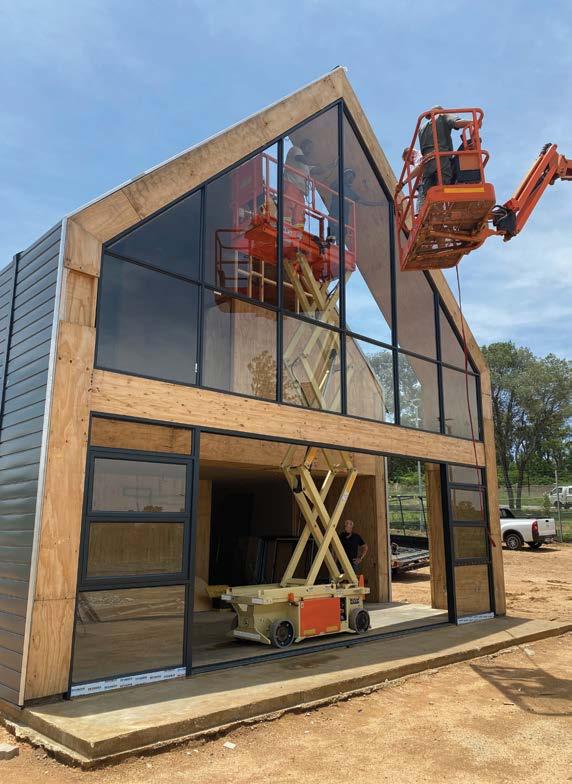

This is understandable, given that less than 1% of new South African houses use timber as the primary construction material. By comparison, some 90% of new houses in New Zealand are made of timber.
As a sector trying to promote the adoption of mass timber, we are faced with a long-held belief that brickand-mortar is the only way to build homes, schools and clinics. There are many misconceptions, not least of which are strength, durability, fire safety, and cost. Many people view wood as rudimentary or weak.
Mass timber uses technological advancements to engineer wood for a more substantial strengthto-weight ratio. In the case of CLT, thin layers of timber are laid crossways before being bonded and compressed together.
It’s been said that wood isn’t manufactured; it grows. From a South African perspective, the wood is sourced from sustainably managed tree plantations.
The forest products sector is the only one to have the trifecta of green solutions when it comes to the carbon sequestration by trees in managed forests, carbon storage in its products and the substitution of carbon-intensive materials with wood-based products.
The construction sector accounts for 35-40% of global energy-related CO2 emissions[1], with a large proportion (embodied emissions) attributable to the extraction, processing and energy-intensive manufacturing of building products. The other primary source is operational emissions from heating, cooling and power generation.
TIMBER
www.tobuild.co.za | winter 2024 77

Wood lends itself well to modern, modular, and off-site construction methods, with improved efficiency and performance.
Timber boasts a significantly lower carbon footprint than traditional building materials like concrete and steel. It also maintains a carbon-negative status throughout its lifecycle, from initial production to disposal, and it sequesters more carbon than it emits during processing and installation.
Academics at Stellenbosch University, Prof Brand Wessels and Dr Philip Crafford, have published research highlighting the advantages of increased timber use in South Africa. Basic modelling analyses show that if the market share of woodbased buildings increases to 20% of new constructions, the residential building sector’s embodied energy and global warming potential could decrease by 4.9%[2]
As our population and economic migration increase, we urgently need to change how we build high-density and singlefamily housing quickly, cost-effectively and sustainably.
There is a climate, economic, and even social case for timber, and there is a significant opportunity for innovation, localisation, and employment creation. Several industry players, such as architects, construction engineers, and producers, are focused on making engineered wood more accessible to the local market. With this comes the need for upskilling or reskilling, as well as business growth and employment opportunities.


Wood lends itself well to modern, modular, and off-site construction methods, with improved efficiency and performance. Single—and multi-storey buildings are prefabricated off-site, allowing for quicker on-site assembly, fewer journeys to and from the site (and the associated carbon emissions), and minimised disruption, dust, and noise.
Biased towards tried-and-tested steel and concrete, public and private sectors are reluctant to drive the use of timber in the built environment through procurement policies.
Through initiatives such as the Forestry Master Plan, partnerships with the Department of Trade, Industry, and Competition, and forward-thinking academia, we want to promote the use of locally grown and processed timber.
The University of Pretoria and Stellenbosch University have a strong wood science focus, helping to educate a new generation of architects and construction engineers.
Dr Schalk Grobbelaar, senior lecturer and chairperson of the York Timbers Chair in Wood Structural Engineering at the University of Pretoria’s Department of Engineering & Technology Management, is a champion for our cause. He believes that a design-led approach is crucial to successful risk management, where timber
solutions are used while exposing people to the possibilities that timber brings.
Dr Grobbelaar’s team has focused on traditional timber frame construction combined with modern CNC machined plywood/OSB modular construction.
Prof Wessels and Dr Crafford have also developed The Wood App (https:// thewoodapp.com), a platform that offers architects, builders, and designers access to a host of CPD-accredited courses on local wood standards, materials, and best practices.
While small compared to other industrial sectors, the sawmilling sector supplies sawn timber and other products for various applications, from structural timber to moulded and machined products for decking, flooring, and ceilings. Many sawmills operate in rural or peri-urban areas, providing much-needed employment to thousands.
The uptake of timber represents a massive opportunity for our country and our planet. It’s time to trust in timber.
References
[1] Global Alliance for Buildings and Construction. 2020, Global Status Report For Buildings And Construction, 4.
[2] Crafford, P. L., & Wessels, C. B. (2020). South African log resource availability and potential environmental impact of timber construction. South African Journal of Science, 116(7/8). https://doi.org/10.17159/sajs.2020/6419
78 winter 2024 | www.tobuild.co.za
Green Dome - Credit Mewa
Sappi pine trees
TIMBER

BOARDS FIBRE CEMENT

• Hardboard
• MDF
• Doorskins
• Chipboard
• Rubberwood tops

• Boards / Planks
• Fascias
• Bargeboards
HARDWOODS SHUTTERPLY

• North & South American
• Asian
• European
• African

• Standard
• Filmface
• H20 Beams
PINE PLYWOOD DECKING OTHER
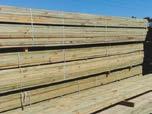
• Treated industrial
• Untreated industrial
• Treated structural
• Laminated pine shelving

• Bending plywood
• Marine Ply
• Pine Ply
• OSB
• Birch Ply
• Commercial
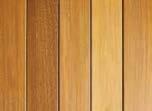
• Balau
• Garapa

• Insulation
Numill Marketing, established in 1989, is a wholesale distribution company specialising in hardwood timber, softwoods and construction related materials, including fibre cement, and value-added timber products like plywood, shutterply and decking.
www.numill.co.za T +27 (0)21 845 4206 | E info@numill.co.za NUMILL M A R K E T I N G
STOCK IS AVAILABLE FROM DISTRIBUTION CENTRES IN CAPE TOWN, GEORGE, GQEBERHA, DURBAN AND JOHANNESBURG
Green flooring solutions emerging

As an exporter, the innovative rubber flooring solutions which helped establish this growing company in the first place continue to highlight its global reach and position it as a local leader in green building solutions, according to the company’s executive management.
According to Dr Mehran Zarrebini, CEO of Mathe Group, strategic partnerships have
helped the company grow while also reducing South Africa’s hazardous buildup of used tyres.
Meanwhile, group sister-company Van Dyck, a recycled rubber flooring company, had embarked on a strategic initiative to enhance the sustainability of its product range by incorporating recycled content.
A MANUFACTURING FACILITY IN HAMMARSDALE THAT RECYCLES APPROXIMATELY 1,000 RADIAL TRUCK TYRES PER DAY TO PRODUCE 45 TONS OF RUBBER CRUMB HAS BECOME A PIVOTAL EXPORT HUB.
Mathe Group
Being limited by the availability of rubber crumb, a crucial component with significant benefits, the company resorted to imports at the outset. “This was paradoxical given the abundance of local waste tyre material”, adds Zarrebini.
“So we engaged with the Mathe Group, a firm based in New Germany with an emerging operation constrained by its waste management licence capacity. Our growing demand soon outstripped their supply capabilities, compelling us to invest in developing a new facility. This not only secured Van Dyck’s supply chain but also presented an opportunity to cultivate the South African market for rubber crumb,” he explains. This increased Mathe’s production capacity six times and new products developed.
Via a collaboration spanning several years with The Flooring Connection (TFC), bringing Van Dyck together with Instafloor - SA and the UK, Van Dyck manufactures the acoustic products at their production facility in Hammarsdale. Offerings include acoustic underlay products and advanced acoustic solutions through the group’s partnership with Instafloor South Africa. TFC plays a critical role in liaising closely with end clients and offering essential technical support, an area in which they have specialisation.
80 winter 2024 | www.tobuild.co.za
FLOORS
Sports cradles.
Jonathan Bodley, head of TFC, says they are dedicated to helping transform the African construction industry, promoting flooring products that align with the circular economy for renovations and new building projects.
Van Dyck’s products are tested to international specifications, allowing TFC to market and export locally-made products that can compete against less sustainable alternatives in terms of quality and cost.



Product range
InstaCradle rubber crumb subflooring cradles were initially used for raised acoustic flooring in the sports and office environment to absorb impact force and sound. Decking applications followed, specifically in situations where waterproofing needed to be protected.
With support from group holding company PFE International, the EcoPaver Cradle was developed for external, permeable paving. It allows for easy water runoff and the creation of water reticulation systems. This has since been used in several waterwise buildings.
“Our rubber crumb underlays, long-used in the flooring industry, are now used as acoustic barriers under standard cement screeds and as low-profile solutions for self-levelling screeds. InstaCradles are now used in acoustic recording studios when installing wall cladding or to support roofing joists. In addition to rooftop decks, the cradles are used to hold the feet of solar geysers,” Bodley adds.
Zarrebini adds that ongoing research and development continue to yield innovative products nearing completion, including acoustic solutions for high-performance gymnasiums and adhesive-free flooring systems.
www.tobuild.co.za | winter 2024 81 FLOORS
Decking cradles.
Paver cradle.
Under screed acoustic underlays.
uPVCa more efficient option for
WINDOWS?
TEVA Heat loss in winter and heat gain in summer are responsible for 25%-30% of all cooling and heating used in residential buildings.
Stephan van Niekerk
South African houses are notorious for being poorly insulated. The reasons for this are not understood entirely, but they certainly include cost. Another factor is undoubtedly the entrenched view that we have a great climate and our winters are short, so we don’t need to build for extreme weather. However, while our winters may generally be brief, they are in fact sharp and the summers are long and hot, argues Stephan van Niekerk, the country manager of REHAU in South Africa (www.rehau.com/za-en).
While modern technologies make it more cost-effective to control the heat or the cold indoors, the energy cost is increasing (as are the penalties for using fossil fuel). Also, the most advanced heating or cooling technologies are less effective if heat transfer between the interior and exterior is not controlled. In short, well-insulated homes stay warmer in winter and cooler in summer, making for a more comfortable environment and reducing energy costs. Insulation also reduces fire risk.
The US Department of Energy says that approximately 30% of a home’s heating energy is lost through windows, while 76% of sunlight enters to become heat in summer. This also depends on the quality of the doors and windows. So, the way a home is designed and the materials used have been shown to have a significant impact on the climate comfort for residents.


Studies by REHAU show that window construction significantly reduces energy consumption. This impact is enhanced when other forms of insulation are used, such as wall and ceiling insulation. Depending on the glazing type, peak energy use in Durban and Johannesburg was shown to be reduced by 23-76%, and in Cape Town by 47-60%.
Timber is one of the best insulators of the material used in window and door structures, but it is expensive to maintain. Aluminium is long-lasting but, unfortunately, is also an excellent conductor, thus facilitating the transfer of heat into the building in summer and cold in the winter.
uPVC has long been the preferred material for energy-efficient windows and doors in Europe, America and Asia. New uPVC technology is making uPVC window and door frames cheaper, overriding what was previously a disincentive.
uPVC’s insulating properties are one reason it is such a good material for door and window frames. Frames made of this material are also fully watertight and minimise drafts—huge factors for day-to-day comfort.
Insulation also plays a role in an often neglected area: noise reduction. Wellconstructed windows can significantly reduce noise from the outside, which affects the well-being of inhabitants, especially in noisy neighbourhoods.
Sustainability is increasingly important, including recycling at the end of a building’s life. uPVC is fully recyclable into new frames, which aligns with the drive towards a circular economy.
For homeowners, maintenance and longevity are important considerations. uPVC frames are manufactured to resist sunlight and salt, making them durable even in harsh weather conditions. You can clean them with dishwashing liquid— no oiling or repainting is needed.
With its emphasis on energy efficiency and sustainability, a new range of materials is coming into its own. One of these is uPVC, which is now more affordable to a broader range of homeowners.
82 winter 2024 | www.tobuild.co.za
WINDOWS & DOORS

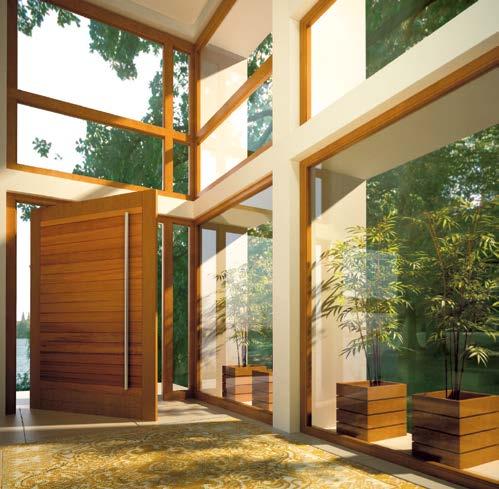
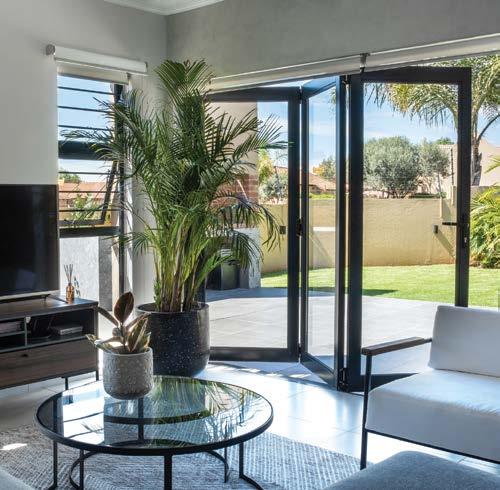

Elevate your living space with unmatched quality.
Swartland has established itself as a paragon of excellence in the realm of doors and windows. Renowned for its unwavering commitment to quality craftsmanship, Swartland produces doors and windows that seamlessly blend durability, functionality, and aesthetic appeal. Each piece reflects meticulous attention to detail, ensuring precision in design and construction. With a focus on innovation and modern design, Swartland doors and windows not only provide robust security and insulation but also elevate the overall aesthetics of any space.

Call us on 086 110 2425 or visit swartland.co.za to view our ranges. Scan the QR code to visit the Swartland website
Cladding caps an outstanding
pan-African steel project

A project noted as highly commended in the Macsteel Pan African Trailblazer category by the judges in the SA Institute of Steel Construction (SAISC) Steel Awards 2023 features has drawn considerable interest as an outstanding example of panAfrican cooperation.
STEEL, ROOFING & CLADDING
84 winter 2024 | www.tobuild.co.za
Gareth Griffiths JTC Building Systems
The project that qualified for that honour was by South African engineering company, JTC Building Systems, which was contracted by client/main contractor Energie Du Nord Kivu to build an extremely remotely located hydro-electric power plant in the far-flung district of Beni, North Kivu, in the Democratic Republic of the Congo.
The region borders the Rwenzori National Park, Uganda, famous for its mountain gorillas.
Toit Oosthuizen, Managing Director of JTC Building Systems and the lead structural engineer on the project, explains, "The project is a hydropower plant with two turbines, used for the generation of power. This area is very remote, and the facility was built to supply electricity to people living in this remote area. Previously, there was no or very limited access to electricity.”





According to the SAISC, the heart of the project was a pre-engineered building (PEB) designed to house two large hydropower-generating turbines. The building also had to support a 35MT overhead gantry, which hoisted and rotated these turbines into place during construction and later servicing. “This structure was a structural marvel," said the SAISC judges in their final report. The building was clad and roofed with AZ150 steel, formed from Zincal® into the Trimflute profile by Safintra in Boksburg.
The finished sheets and cladding sections were delivered to JTC, who shipped them in containers via Durban and then on to Mombasa. Then, it was road-freighted 1600 km to Butembo, DRC, on a hazardous route through two East African countries, from where it was again road-freighted to the remote site.
STEEL, ROOFING & CLADDING
www.tobuild.co.za | winter 2024 85


Professional team
Client
Main contractor
Structural engineer
Steelwork contractor
Steel detailer
Roofing and cladding manufacturer
Steel profile roll former
Steel merchant
Working site photography
Energie Du Nord Kivu
Energie Du Nord Kivu
JTC Building Systems
JTC Building Systems/C.I.S. Engineering
JTC Building Systems
Safal Steel
SAFINTRA
Allied Steelrode
JTC Building Systems
A further project was the pre-fabrication into components that could be transported and the installation of a channel bridge spanning 30m over a valley-sized 2x2x2 m2 supported by two sets of internal lattice column structures. This structure had to be manually ported and assembled within the valley, assisted by site workers and a basic pulley structure operated from the sides of the valley.
Located in a wild, security-risk area, the site constraints were daunting and had to be considered when designing the steel members for the plant, especially the channel bridge.
JTC in Vereeniging did the design and engineering work in South Africa, and CIS Engineering in Vanderbijlpark fabricated the PE elements required for onsite assembly. François Engelbrecht, also of JTC, was the steel detailer.
The South African engineers also sent a supervisor to the site to manage the erection of the water channel and main building.
“Fabricators and manufacturers have really forged ahead and made a big leap into Africa! They have built structures in a way that has never been done before, delivering products and innovations which have never been seen before – not only locally but across the continent,” says SAISC Chief Executive Officer (CEO) Amanuel Gebremeskel.
86 winter 2024 | www.tobuild.co.za STEEL, ROOFING & CLADDING

FOR GOOD M FOREVER
Genuine clay brick does not rot, tarnish, fade, rust, scuff, peel, erode or burn. It’s a natural insulator against summer heat, winter cold, humidity and noise. With timeless appeal AND impressive strength, clay brick looks beautiful for a lifetime.
Clay brick is a natural insulator against winter cold, summer heat, humidity and noise. With stylish, timeless appeal and impressive sustainability credentials - the enduring hues and textures of clay brick are low maintenance and look beautiful for a lifetime.
CBASA represents clay brick & paver manufacturers across Southern Africa. We drive inclusive, sustainable practices in the industry while supporting our local producers, builders and architects.
CBASA represents clay brick & paver manufacturers across Southern Africa and drives inclusive, sustainable practices in the industry. We inspire energy-efficient, contemporary architecture and paving that supports our local producers, builders and architects.
CUT COOLING & HEATING COSTS
CUT COOLING & HEATING COSTS
Download free technical & construction guides at www.claybrick.org
Download free technical & construction guides for clay bricks & pavers at www.claybrick.org
CLAYBRICK.ORG EHT ECIOVEHT FO T H E CLAYBRICK INDUSTRY ASSOCIATION STYLE SUSTAIN SAVE SECURE
CLAYBRICK.ORG ECIOVEHT O ECIOVEHT FO T H E CLAYBRICK INDUSTRY ASSOCIATION STYLE SUSTAIN SAVE SECURE
Starlite® roof & side cladding
insulation continues to be the forerunner
For most industrial, commercial, retail, medical, residential, government and related construction projects in South Africa, including Sub-Saharan Africa and the Indian Ocean Islands.



88 winter 2024 | www.tobuild.co.za
ADVERTORIAL
Takealot
Jubilee Crossing Mall Compass Cargo

Starlite® was the first faced fibre roof insulation material in South Africa to achieve an A1 (noncombustible) fire rating. This ensures absolute peace of mind for property owners and their insurance underwriters that their buildings are fully compliant from a fire risk point of view. Launched in 2004, Starlite® has become synonymous with being the first choice of roof insulation for developers, professionals, and contractors alike. Starlite® is also an eco-friendly “green” product with the fibre being made from molten natural raw materials, including up to 80% post-consumer recycled material. Starlite® production does not produce any blowing agents, is CFC-free and does not affect the earth’s stratospheric ozone layer, ensuring it has zero ozone depleting potential (ODP).
As well as having very effective thermal and acoustic properties, Starlite® offers excellent performance-to-cost ratios, making it one of, if not the, most affordable roof insulation materials in the relevant market segment. This ultimately translates into substantial cost savings for all parties involved on a particular project. Being affordable, however, does not mean compromising on quality, which is why Starlite® is the market leader in aesthetically pleasing faced fibre roof insulation materials in South Africa.



www.tobuild.co.za | winter 2024 89 ADVERTORIAL
Starlite Black Faced - Avianto
Victoria Urban Terminal - Mauritius
Woolworths
About D&D Roof Insulations
Starlite® is distributed nationally and exported by D&D Roof Insulations. The company was established in 1999 and has evolved over the years to become the premier supplier of most commercially available roof, cladding, ceiling, and building insulation materials of all types and for all applications. With head office in Pretoria and a national distribution footprint including all the major centres in South Africa, the SADC region and Mauritius, they are perfectly positioned to ensure that all manufacturing and delivery requirements are timeously met. D&D Roof Insulations is dedicated to providing outstanding quality, service, and satisfaction to all its clients and customers. This includes guaranteeing the highest level of technical advice, support and thermal insulation data and criteria as stipulated by the relevant SANS standards as part of the South African National Building Regulations. D&D Roof Insulations is also a founding and Platinum member of the Thermal Insulation Products & Systems Association of South Africa (TIPSASA), and has representation on the Board of TIPSASA. As a result, D&D Roof Insulations has consistently provided invaluable contributions to furthering the R&D, adoption, creation and, ultimately, the regulation of a sustainable, energy-efficient environment in South Africa through the use of the correct building insulation materials. Its team of

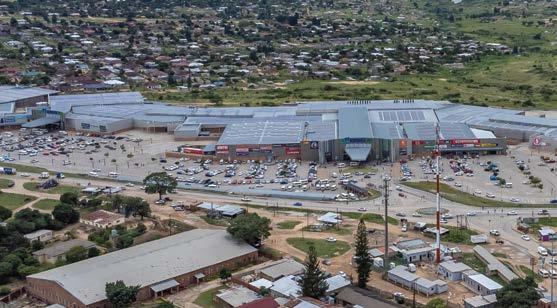
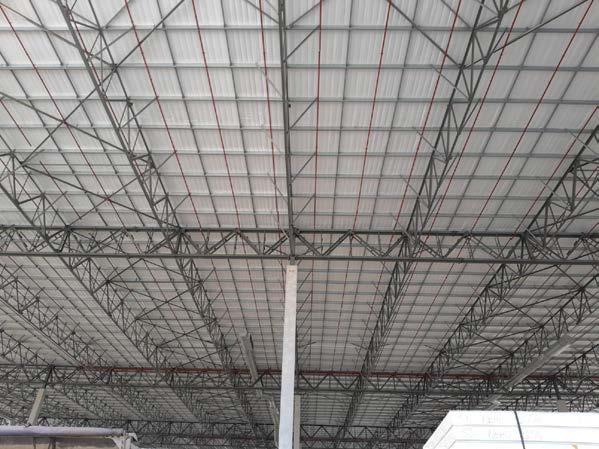
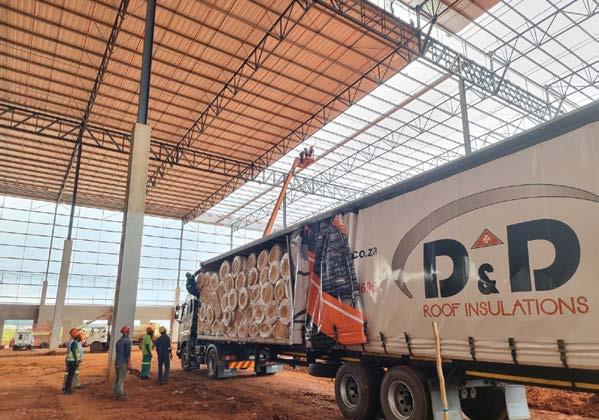
dedicated personnel is always available to assist from the design stage right through to completion to ensure the correct product is used and applied for the relevant application required. For service, price, and good advice, contact the Thermal & Acoustic Insulation Specialists.
www.roofinsulation.co.za
info@roofinsulation.co.za
Tel: 012-800 3606


ADVERTORIAL D&D Roof Insulations
Steve Tshwete District Hospital - Middelburg
Acornhoek Mall
Shoprite DC - Gqeberha
90 winter 2024 | www.tobuild.co.za
Massmart DC
Starlite® was the first Flexible faced Fibre Roof Insulaaon in South Africa to achieve an A1 (Non-Combusable) fire raang. Starlite® also offers one of the best comfort-to-cost raaos on the market making it very affordable for most applicaaons Since the products launch in 2004, Starlite® has become the preferred choice of roof insulaaon by many specifying professionals for most large format steel structures.


World environment day 2024 and cellulose fibre
On the 5th of June, we celebrate World Environment Day where people and businesses should pause to examine their operations and footprint on the planet. With the hashtag #GenerationRestoration, just what can be done by suppliers to move towards climate goals in this era of global warming?
Gareth Griffiths
According to Eric Quarmby, the CEO of Green Fibre Insulation, the required changes particularly affect the building industry where conservative estimates state that the construction and building operations sectors are by far the largest emitter of greenhouse gases, accounting for a staggering 37% of global emissions.
“GFI is a major producer of cellulose fibre insulation in South Africa, where it is used in homes and commercial buildings as a blanket insulation that is blown into the roof or other cavity where it settles and forms a barrier of thick insulation, helping to greatly slow the progress of heat into and out of the building”, he says.
Leading brand, Thermguard Cellulose Fibre Insulation (www.thermguard.co.za), is made from milled cellulose fibre, sourced from recycled newsprint and other printed matter. It is treated with a flame retardant and exhaustively tested for performance so it complies with national standards and also does not support fire in the roof. Professional installers blow it into place and it quickly spreads across the ceiling inside the roof space or other cavity in the home.
Once it is properly installed, it traps a layer of air inside and slows down the movement

of heat (or cold) across that layer. The installers refer to that as the blanket effect. Think of a giant fluffy blanket across the ceiling or inside the roofing cavity.
The use of building insulation is well known as a required step in keeping the building occupants passively warm in winter and cool in summer (meaning much less use of heating or air conditioning respectively) thus saving “operating” energy for the building. However there are a number of other wider benefits.
Every building material arriving on site has a source and a journey from raw material to building site. It comes with a carbon-related legacy (footprint) as to its source, how it is obtained, its manufacturing process into insulation and its transport and installation in the home or building. This is, very simply put, the concept of embodied carbon and energy.
“Cellulose fibre, because it is a recycled natural raw material, enters its lifecycle with an embodied carbon of zero. It arrives at its place of manufacture with a minimal carbon/energy content especially when collected by casual recyclers. Once there, the manufacturing processes used are low energy and a minimal amount of water is used” says Quarmby.
Talking carbon and energy number
Thanks to the low energy mechanical production process from recycled cellulose waste to which a small amount of fireretardant salt is added, the embodied energy content of prepared cellulose fibre insulation leaving the factory gate is rated between 12.25 MJ/kg/m2 installed in the ICE 2* guide as published by the Building Services Research and Information Association (BSRIA). This is lowest in class by a wide margin, the next closest being typical glass wool insulation at 68.04 MJ/kg/m2 (international figures). In addition, cellulose fibre insulation offers the lowest in class embodied carbon/energy content per installed unit.
Thereafter, the carbon/energy cost of transporting it to site is reduced due to the used of a simple bakkie and trailer which uses less fuel, thanks to the lightweight nature of the substrate.
More detailed information is available from the manufacturer.
*The ICE 2 Guide is regarded as an industry standard based on research work done by a leading Bath University research team (ref. Hammond & Jones) and funded by the Carbon Trust and Engineering and Physical Sciences Research Council.
INSULATION
92 winter 2024 | www.tobuild.co.za
Casual/street recyclers deliver newsprint waste to factory.






















The benefits of
effective home insulation
Ensuring that your home is properly insulated during the winter months can significantly improve your comfort levels and energy efficiency. In South Africa, where climate conditions vary from region to region, the importance of adequate insulation cannot be overstated. One popular and effective option for insulating your ceiling is Aerolite® Soft Touch, a high-quality product known for its thermal properties and energy-saving benefits.
One key factor to consider regarding insulating materials is the R-value. This value represents the material’s thermal resistance, with higher R-values indicating better insulation properties. Different regions in South Africa experience varying climate conditions, which affect the required R-value for effective insulation. In regions like the Western Cape or Gauteng, higher R-values are necessary compared to warmer regions like KwaZulu-Natal.
Aerolite Soft Touch provides excellent insulation across various climate conditions, making it a versatile choice for homeowners throughout South Africa. With its softer feel and easy-to-install factor, Aerolite Soft Touch offers a comfortable and safe option for ceiling insulation. Its high R-value ensures that heat is retained within the home during winter, reducing the need for excessive heating and ultimately lowering energy costs.
One of Aerolite Soft Touch’s key advantages is its remarkable ability to regulate indoor temperatures, ensuring warmth in winter and coolness in summer. By minimising heat transfer through the ceiling, Aerolite Soft Touch helps maintain a consistent and pleasant living environment year-round, reducing the reliance on heating and cooling systems. This not only enhances residents’ comfort but also leads to significant energy savings and reduced utility expenses.
Aside from its thermal and acoustic properties, Aerolite is environmentally friendly. It is crafted from 80% recycled glass that prioritises environmental safety. Its long lifespan makes it a wise investment for homeowners seeking to enhance their homes’ energy efficiency and comfort.
This winter, Professor Aerolite (our insulation expert) will be de-bunking common myths surrounding this vital aspect of home comfort. Watch as we shed light on the benefits of Aerolite Soft Touch ceiling
insulation. We offer exclusive promotions in retail stores to make home insulation more accessible and practical for homeowners. We encourage homeowners across South Africa to seize the opportunity to upgrade their living spaces with top-tier insulation endorsed by Professor Aerolite, ensuring a blend of comfort and savings for the long term.
Whether you call a colder climate like the Highveld home or reside in a milder region such as the Lowveld, opting for Aerolite Soft Touch insulation for your ceiling can substantially impact your home's energy performance. Make a proactive choice this winter by choosing Aerolite Soft Touch for a snug, energy-efficient home that promises enduring benefits for you and your loved ones.
To learn more about Aerolite Soft Touch, visit: https://shorturl.at/ bprSU

ADVERTORIAL
94 winter 2024 | www.tobuild.co.za

Aerolite® Soft Touch ceiling insulation
Designed to improve the energy efficiency, safety and thermal comfort of a building.
Aerolite® Soft Touch ceiling insulation is the key to unlocking thermal comfort, acoustic pleasure and energy savings.
Locally manufactured using up to 80% recycled glass, Aerolite® is the non-combustible insulation solution to keep your family safe, your home comfy all year round and save big on energy costs.








The evolution
of bean to cup
Over the last few decades, the evolution of coffee culture has been entirely reshaped by technology. Recently, there has been an explosion of bean-to-cup coffee machines. These appliances offer convenience, quality, and sustainability, transforming the at-home coffee experience. We look at the ins and outs of this growing new technology.
Miele

KITCHENS
96 winter 2024 | www.tobuild.co.za
Sicelo Champion, an expert from Miele South Africa, explains, “Bean-to-cup coffee machines have truly revolutionised home coffee brewing, providing an unparalleled level of convenience and quality." Indeed, these machines have become a gamechanger for coffee enthusiasts worldwide, offering a level of customisation and control that was previously only accessible to professional baristas.
A fresh grind
“It's common to consume coffee within a few weeks of roasting for the best flavour. Storing beans in an airtight, cool, and dark place can help prolong their freshness. Our airtight bean containers can help maintain the beans' freshness for several weeks, ensuring a flavourful cup of coffee each time”, notes Sicelo.
Grinding coffee increases its surface area, hastening oxidation (and flavour loss), so it’s best to store whole beans and grind them just before brewing. One of the key features of any beanto-cup coffee machine is its ability to grind fresh coffee beans on demand, ensuring maximum freshness and flavour in every cup, and minimising the time the coffee spends in granular form.
The secret to an excellent bean-to-cup machine lies in the quality of the grinder used. Sicelo says that Miele machines boast an innovative low-noise conical grinder that grinds the beans for each cup of coffee, which is then brewed immediately.
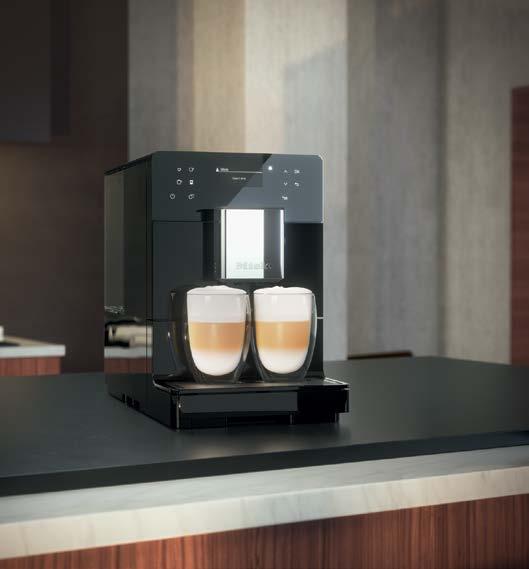
Simple and easy
it’s best to store whole beans and grind them just before brewing.

Beyond the superior quality of the coffee, bean-to-cup machines have also revolutionised how we perceive and interact with coffee. The convenience factor cannot be overstated, as these machines offer automation that simplifies the brewing process. With the touch of a button, users can enjoy a freshly brewed cup of coffee tailored to their preferences. This convenience has contributed to the growing trend of at-home coffee enthusiasts. Beanto-cup machines have facilitated the rise of specialty coffee, with an emphasis on quality, origin, and unique flavour profiles.
Sicelo elaborates: “Quality coffee machines offer a wide variety of automatic settings for every type of coffee beverage. Ours also allows you to personalise the experience. You can even save the settings for your favourite drink in the user profiles.”
Benefits
Another great benefit of bean-to-cup machines is environmental. With their built-in grinders and brewing mechanisms, these machines reduce the need for singleuse pods or capsules, which are known to contribute to waste streams. Hence, bean-to-cup coffee machines offer a real option to be part of the growing at-home and in-office coffee culture that values quality, convenience, and sustainability - and minimises waste.
KITCHENS
www.tobuild.co.za | winter 2024 97
ALLIANCE ROOFTOP INVERTERS:
The pinnacle of comfort & climate control
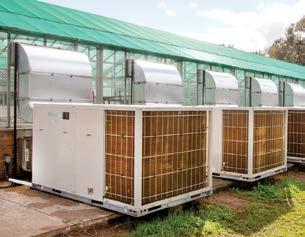
Alliance, a leading name in South Africa's air-conditioning and water-heating market, introduces their Rooftop Inverters series, redefining climate control in architectural projects. These innovative Rooftop units are full inverters, compressor speeds can be varied to ensure precise temperature control and optimal indoor environments year-round. With a legacy of excellence since 2006, Alliance merges innovative technology with unparalleled efficiency and durability to deliver the ultimate comfort experience.

Unparalleled efficiency for modern spaces
The Alliance Rooftop Inverters range offers heating and cooling capacities from 29kW to 108kW, ensuring optimal climate control for various project scales. Utilising advanced inverter compressor technology, these units adeptly modulate their operating frequency and capacity output to align with the varying demands of different spaces. This adaptability not only guarantees the comfort of the room environment but also significantly reduces power consumption. Meeting stringent CB requirements, the Alliance Rooftop Inverters offer a smart, high-efficiency solution for both commercial and light commercial settings, maintaining consistent, comfortable temperatures while optimising energy usage.
Innovative technology and sustainable performance
Embodying the cutting edge in climate control, Alliance Rooftop Inverters utilise advanced heat pump technology combined with 3-phase power. These units not only withstand rigorous testing, including a 1000-hour salt spray test but also high performance across various environmental conditions. Enhanced by a multiple protection design, including high voltage, low voltage, overcurrent, discharge, and phase sequence protections, the Alliance Rooftop models safeguard critical components like the compressor and motor against abnormal operation and severe conditions. This comprehensive protection extends the unit's lifespan while ensuring safer and more reliable performance.
Designed with safety and convenience in mind
Alliance prioritises safety and ease of use in every design. Our Rooftop Inverters are equipped with comprehensive sensor protections for system current, high/low pressure, and temperature, ensuring reliable operation. The self-diagnostic functions and external service valves facilitate swift maintenance and troubleshooting, minimising downtime and enhancing user convenience.
Reliable support and nationwide reach
Alliance's dedication to quality and reliability is underscored by a 2-year compressor warranty and a 1-year unit warranty. Their expansive network, supported by the reputable Fourways Group, ensures that expert assistance and support are always accessible. With service centres across South Africa, Alliance is your trusted partner in climate control, bringing comfort and luxury to your architectural endeavours.
98 winter 2024 | www.tobuild.co.za
ADVERTORIAL
Transform your projects with Alliance Rooftop Inverters by contacting Alliance today: KZN: (031) 579-1895 | Pretoria: (012) 643-0445 | CPT: (021) 556-8292 | JHB & Central: (011) 704-6320 EL: (043) 722-0671 | Gqeberha (PE): (041) 484 6413
THE PINNACLE OF COMFORT ROOFTOP INVERTERS

Elevate your architectural projects with the latest in climate control technology from Alliance, South Africa’s trusted name in air conditioning and water heating.

UNMATCHED EFFICIENCY AND DURABILITY
The Alliance Rooftop unit, meeting CB requirements, adjusts its frequency and capacity for optimal room comfort and low power consumption, offering high efficiency and energy savings.
INNOVATIVE TECHNOLOGY FOR SUPERIOR PERFORMANCE
Heating & cooling pump technology and 3-phase power in units that pass the 1000-hour salt spray test, highlighting our commitment to durable and highperformance solutions.
SAFETY AND CONVENIENCE AT ITS CORE
The Alliance Rooftop unit features multiple protections, including high/low voltage and overcurrent, safeguarding components under harsh conditions for safer, longerlasting operation.
YOUR TRUSTED PARTNER IN CLIMATE CONTROL
Alliance stands behind its promise of quality and reliability with a 2-year warranty on the compressor and a 1-year warranty on the unit. Our nationwide presence, backed by the reputable Fourways Group, guarantees that expert support is always within reach.
SINCE 2006, ALLIANCE HAS GROWN TO BECOME A LEADING BRAND IN AIR CONDITIONING AND WATER HEATING SOLUTIONS IN SOUTH AFRICA.
Our commitment to quality service, value-for-money products, and technological innovation continues to drive us forward, fulfilling our promise of delivering homely comfort and luxury to every space.
CONTACT US:
SEE MORE: www.allianceafrica.co.za
PRETORIA: (012) 643-0445 | GQEBERHA (PE): (041) 484-6413 | CPT: (021) 556-8292 KZN: (031) 579-1895 | JHB & CENTRAL: (011) 704-6320 | EL: (043) 722-0671
SOLAR INFRASTRUCTURE –
the future of energy security?
For this edition of To Build, we welcome Michael Pienaar, the sustainable infrastructure development and zone operations specialist at the Atlantis Special Economic Zone, as our special writer. Pienaar argues that solar infrastructure represents the vanguard of energy security for residential, commercial, and industrial developments.
With its multiple benefits ranging from financial feasibility to predictability in yield, solar power emerges as a formidable contender in the quest for sustainable energy solutions.

Firstly, the financial allure of solar infrastructure is undeniable. At an infrastructure development cost of approximately R 30 000 per kW of installed capacity, solar power stands head and shoulders above other energy sources in terms of costeffectiveness. This economic advantage makes solar energy an attractive option for individuals and businesses and lays a solid foundation for long-term savings and sustainability.
RENEWABLE ENERGY
Michael Pienaar
100 winter 2024 | www.tobuild.co.za
Moreover, the modular nature of solar infrastructure adds a layer of versatility unmatched by traditional energy systems. From small-scale installations to expansive projects spanning vast swathes of land, solar power offers scalability with unparalleled ease. This adaptability enables developers to tailor solar solutions to meet evolving energy demands, whether for a humble residence or a sprawling industrial complex. Furthermore, the incremental scalability allows for phased expansion over time, aligning seamlessly with the growth trajectories of diverse developments.
One of the most compelling aspects of solar infrastructure is its predictability. While the notion of predictability might lack the excitement of cutting-edge innovation, this reliability places solar power at the heart of energy planning. Solar energy delivers a steady and foreseeable yield, providing stakeholders with a clear understanding of the returns on their investment. This contrasts with many other energy sources, so this predictability instils confidence in financial projections and fosters stability in the energy supply. It mitigates the risks
associated with volatile markets, untested technology and geopolitical uncertainties.
Importantly, the execution of solar infrastructure projects sets a benchmark for efficiency and reliability. Contrary to the stereotype of protracted and overbudget ventures, solar projects exhibit a remarkable track record of success. A recent study revealed that solar projects boast a mean cost overrun of merely 1% (see Table 1 below). This is undoubtedly a testament to the execution characteristics of solar infrastructure. This commendable performance not only underscores the viability of solar energy but also instils trust in stakeholders, paving the way for continued investment and expansion in the solar sector.
In summary, solar infrastructure emerges as a beacon of hope for energy security in infrastructure development. With its unrivalled financial feasibility, modular scalability, predictable yield, and exemplary execution, solar power stands poised to continue revolutionising the energy landscape.

Bringing it home
The Atlantis Special Economic Zone enthusiastically incorporates solar infrastructure in our development strategy, while we provide world-class industrial facilities to manufacturers in the solar infrastructure domain.
On the journey towards a sustainable future, embracing solar energy is not merely a choice but a responsibility to safeguard our planet and secure a brighter tomorrow for future generations.

RENEWABLE ENERGY Project Type Mean Cost Overrun (%) Nuclear Storage 238 Olympic Games 157 Nuclear Power 120 Hydroelectric Dams 75 IT 73 Nonhydroelectric dams 71 Buildings 62 Aerospace 60 Defence 53 Bus Rapid Transit 40 Rail 39 Airports 39 Tunnels 37 Oil and gas 34 Ports 32 Hospitals, health 29 Mining 27 Bridges 26 Water 20 Fossil thermal power 16 Roads 16 Pipelines 14 Wind power 13 Energy transmission 8 Solar power 1 Table 1 – Mean Cost Overruns from the Flyvbjerg Database
www.tobuild.co.za | winter 2024 101
Michael Pienaar



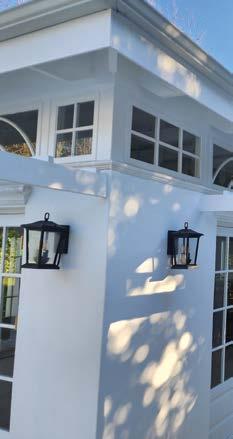


www.speedworx.co.za





Our vast array of specialised services ensure you or your company receive personalised attention, with tailor-made solutions for your building and/or renovation projects. We offer environmentally friendly sustainable solutions, and pride ourselves on providing quality workmanship and excellent customer service.
082 785 7426 info@speedworx.co.za
Restoring the past Building the Future
Is your garden
winter-ready?
As the nights draw in and the temperatures start to drop, it's time to start thinking about getting your garden ready for winter. From cutting back plants to collecting leaves, a popular supplier of garden implements has sent us all the tips and tools you need to prepare for the coming season.



Don’t be intimidated by cold, freezing weather. Instead, welcome the cold season with confidence, knowing your outdoor space is cared for even during the frostiest days.
Cutting back first - pruning and lopping
As winter approaches, it's important to cut back plants and tidy up your garden. A variety of tools, such as secateurs (pruning scissors) and a tree and pruning lopper will help to make the job easier and more efficient. By lightly trimming back dead foliage and branches, plants should stay healthy and strong during the colder months.
Leading supplier, Gardena ( www.gardena.com/za) recommends:
• cutting away loose or dying branches from trees;
• cutting sick or dead sections from shrubs;
• pruning evergreen hedges and overgrown climbers;
• deadheading faded perennial plants like roses by cutting the stem just above the first leaf.
GARDEN IMPLEMENTS
Gardena
104 winter 2024 | www.tobuild.co.za

TLC for the lawn: cutting
Give the lawn a good cut before the first frost, ensuring that the height is between four and five centimetres. Taller blades of grass are prone to fungal disease after frost damage, while the shorter ones cannot protect grass roots from frost. Make sure you remove the cut grass from the lawn to allow light and air to circulate and prevent rot. Hint: Try any of a range of robotic, battery and electric-powered lawn mowers.
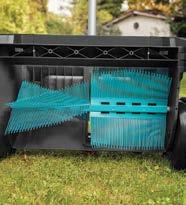
Turning the fall season chores into useful materials - raking and brushing
As the trees shed their leaves, it can seem like a never-ending chore to remove them. However, this is an important task as the leaf coverage can suffocate grass and cause rot. So instead of raking up and binning it, Why not use it for compost or mulch?
The supplier suggests their leaf and lawn collector, a clever device that brushes up the leaves as you push it over the required area, dropping them into a removable basket. Rakes make it easy to gather up leaves and turn them into valuable organic matter for your garden. Leaves can also be used as winter protection for frost-sensitive plant beds. Simply scatter the leaves over the beds and cover them with a thin layer of earth to prevent the leaves from blowing away. By recycling your leaves in this way, you can help nourish the soil and promote healthy plant growth in the spring.
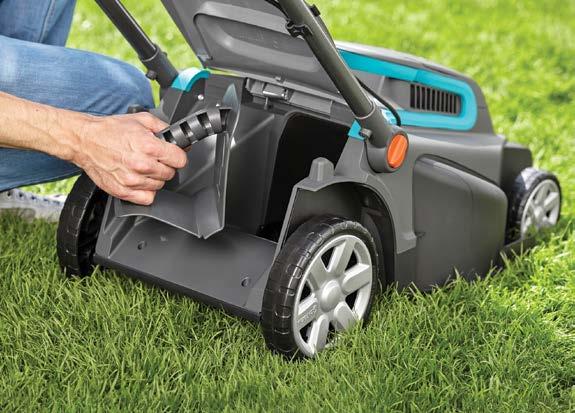

Water wisely
Your garden needs less water in winter. It is advisable to water your garden early in the morning to allow the surface water to dry and the soil to warm up, reducing the risk of damage due to frost at night. Our interviewee, Gardena, offers automated watering tools including a water control select irrigation system which can be set to water less frequently at this time. Try those, or similar.
As autumn turns to winter, it's important to stay on top of garden maintenance to ensure your outdoor space remains neat and tidy. Using these simple tips will help toward keeping your garden in good condition; make your winter work in the garden happier and set you on the road towards a fabulous garden revival in the spring.
GARDEN IMPLEMENTS
www.tobuild.co.za | winter 2024 105
GLASS REINFORCED POLYESTER
THE RIGHT CHOICE FOR PROTECTING YOUR EQUIPMENT AGAINST THE ELEMENTS


ALLBROX
The most advanced range of industrial enclosures in the world. The Allbrox® is an extremely versatile range of electrical enclosures, suitable for harsh and challenging conditions.
- All-Guard coating - IP66 weatherproof
- IK10 strength - 25+ year UV life

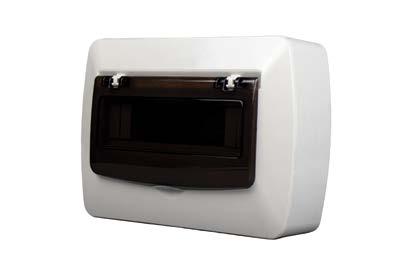








CAMERA-DEN
The first of its kind: a revolutionary camera-mounting system. The Camera-Den ™ can halve your installation time and reduce costs by up to 90%. (Including labour)
- Available sizes: 90mm and 110mm
- IP66 weatherproof
ALL-ROBUST
The All-Robust is designed to withstand outdoor weather conditions. This range can be used to house isolator switches on DC solar installations, up to 4 pole DIN breakers, system switches, etc.

- IP66 weatherproof
- IK10 strength




ALL-DB


A ground-breaking innovation that is set to transform the landscape of home power distribution. The ALL-DB range is made from Glass Reinforced Polyester, with superior insulation and flame-resistant properties, making it the preferred material for increased electrical safety and solar energy systems.
- IP4X
- - Available in 8,13 and 26 way

Tel: + 27 11 894 8341 Email: new@allbro.com www. allbro .com


086

166 7242
Autumn Fairy
www.douglasjones.co.za | info@douglasjones.co.za B1 Prime Park, Mocke Road, Diep River, Cape Town

Conquer the Digital realm Dream Big
We're more than a company
We're a driving force that propels dreams into digital reality. -

Domains

Web Hosting
Web Design / Development
Search Engine Optimisation
Google Ads
Social Media Marketing
info@ixist.co.za

www.ixist.co.za












To subscribe: Scan the QR code or visit www.tobuild.co.za and subscribe online. Featuring creative and insightful content on the latest developments, trends and news, including interior and exterior decor, architecture and building technologies. Subscribe to To Build, the publication for all who have an interest in renovation projects! Save 30% on the next 4 editions and have it delivered to your door. This offer is valid until 28 February 2025 and applies to print subscribers with a South African address only. By providing your personal details, you are giving To Build magazine permission to communicate and add you to our mailing list. R154 ONLY A YEAR Call us for more info: 031 792 6500 www.sika.co.za CONSTRUCT THE WORLD BEYOND THE EXPECTED Waterproofing Sealing and Bonding Anchoring and Grouting Concrete Repair and Protection Flooring Roofing 110 winter 2024 | www.tobuild.co.za Volume 14 Issue 2 9772219724008 24014 R55.00 Incl. VAT WINTER 2024 to build MIFPM - a showcase in steel construction p28 Goodbye yellow brick road p44 Thermo Fireplaces and Braais: winter-ready?Is your winter-ready? lighting Get the right indoors - expert advice Building? Building? GARDEN Consider the crucial costs COVER FEATURE where quality and workmanship meet WHAT’SNEW? Luxury hometrends Fireplaces and Braais:





08-03 07-03 06-03 05-03 04-03 03-03 02-03 01-03 08-01 07-01 06-01 05-01 04-01 03-01 02-01 01-01 09-01 08-01 07-01 06-01 05-01 04-01 03-01 02-01 01-01 08-02 07-02 06-02 05-02 04-02 03-02 02-02 01-02 09-01 08-01 07-01 06-01 05-01 04-01 03-01 02-01 01-01 Wind Free™ everywhere DVM S2 WindFreeTM Digital Variable Multi Compatible











































































































































































































































































































 All our shown and mentioned decors are reproductions.
All our shown and mentioned decors are reproductions.




































































































































